71 really clever ideas to make open-plan work for everyone
How to master open-plan design
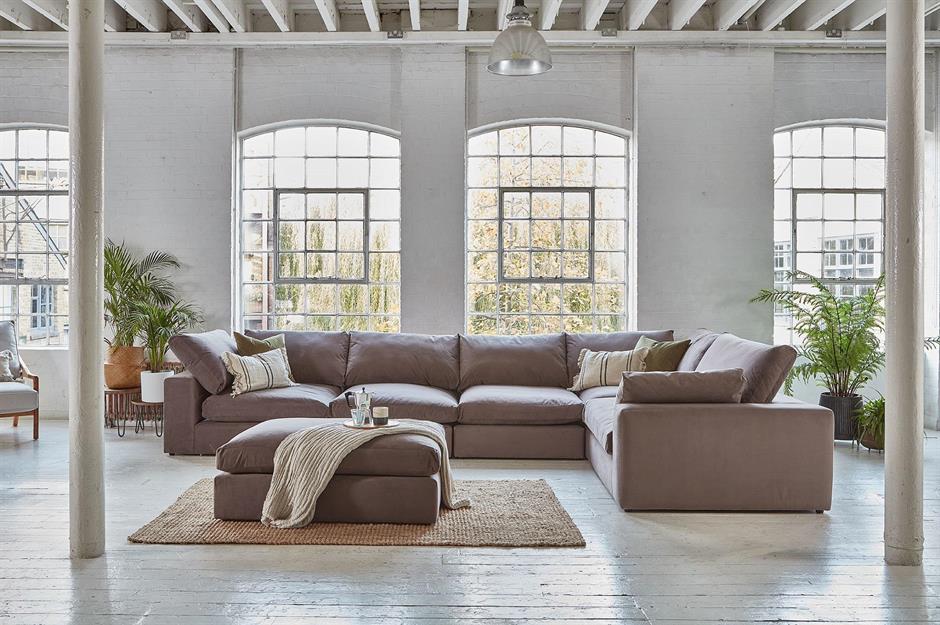
An open-plan scheme is a natural choice for sociable, modern living, but a free-flowing floor plan requires careful planning and execution to make sure the space really works. From a large, broken-plan hub fit for the whole family to a multitasking studio apartment setup, here's how to master the secret to open-plan living design, no matter the size or style of your home. Click or scroll on for more...
Use coordinated colour throughout
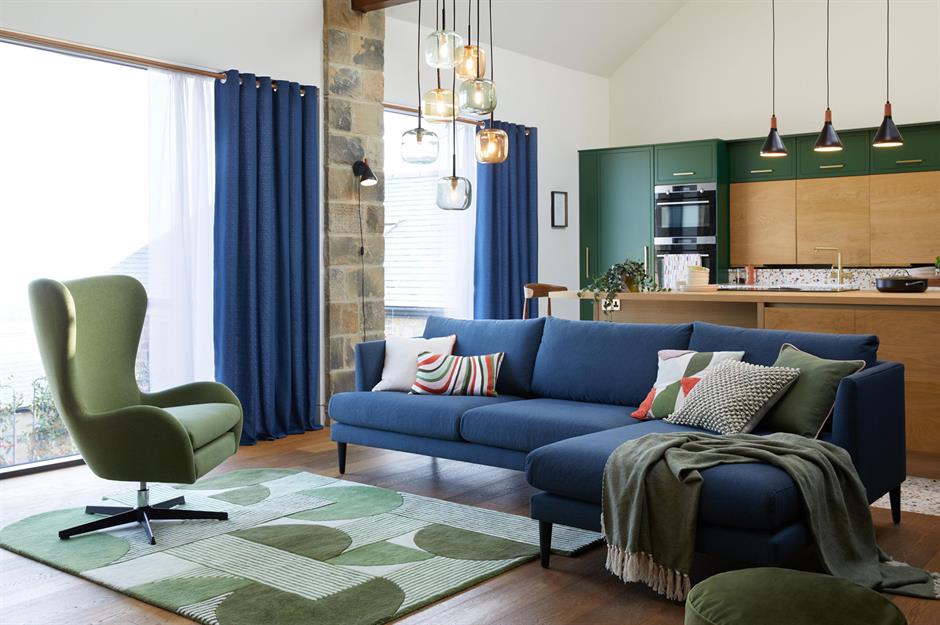
In a smaller open-plan space such as an apartment use the same colours throughout to keep the room organised and unified. Here, green modern forest green kitchen cabinetry is linked to the living space by green soft furnishings. A striking blue sofa blends with matching blue curtains on both the living room and kitchen windows.
Zone areas with rugs
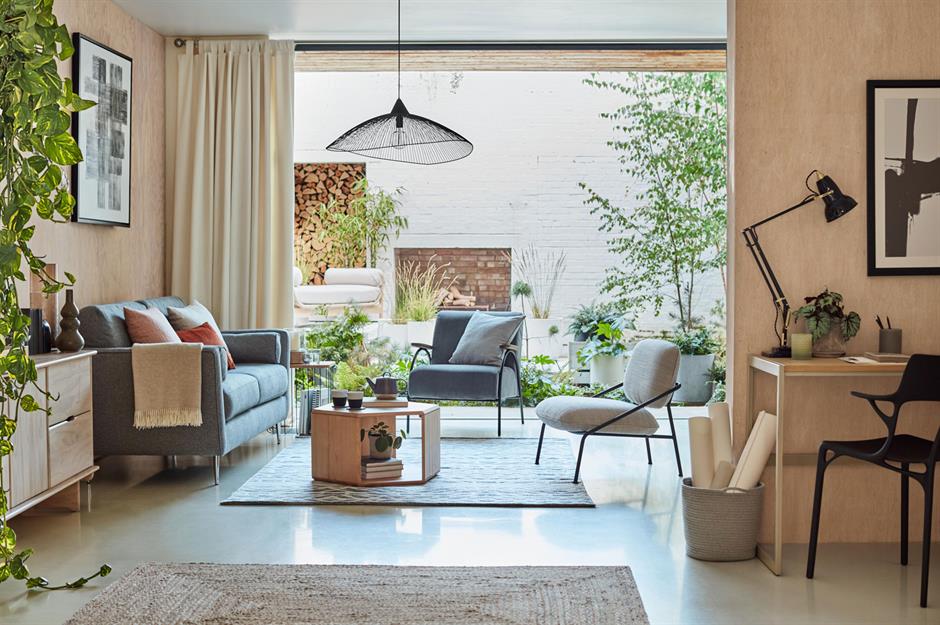
Ground areas of your open-plan living space with tactile rugs. Pop an area rug under and in front of the sofa to increase the sense of living space. Choose a complementary style to pop under the dining table; this creates an island scene. Or, a runner will guide traffic flow into other spaces and rooms.
Decorate the back of the sofa
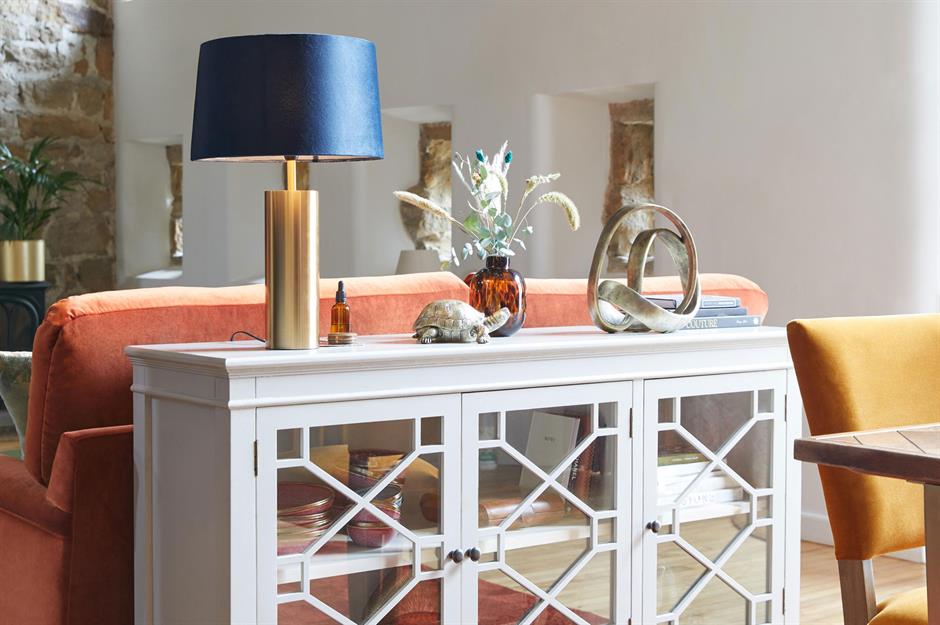
It's common in open-plan spaces to have seating set out strategically creating a living zone. But this often means the back of the sofa is exposed. The solution? Bring in a sideboard. Cleverly placed it will not only cover up the bare sofa behind but will divide the areas more sufficiently. The extra surface can be used to add a table lamp and decorative accessories.
Call in the experts
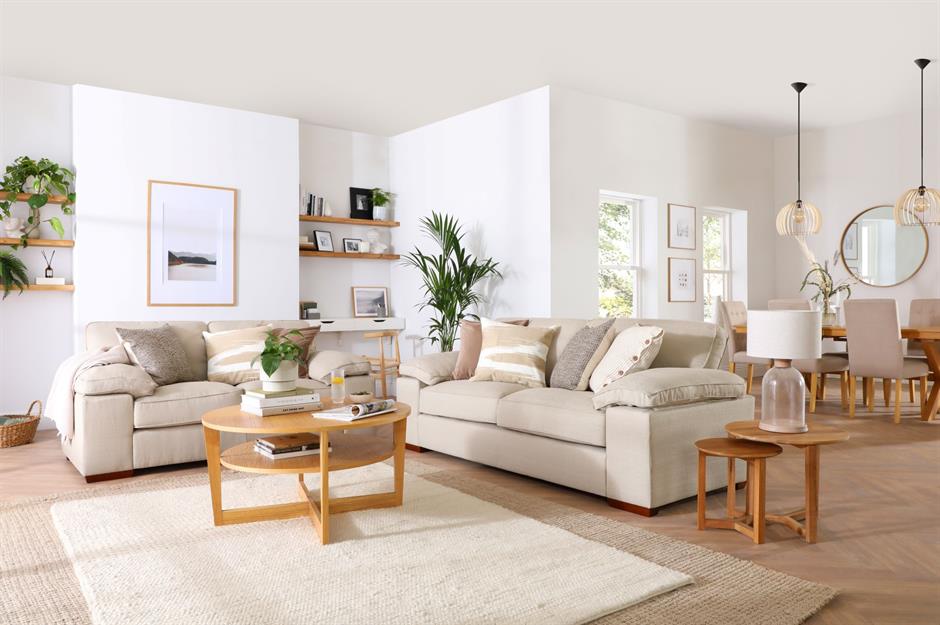
If you’re planning to knock down walls and create an open-plan scheme in your current home, then you’ll definitely need help making the job a success. Experts will not only be able to complete the work to a high standard, but ensure that load-bearing walls are retained, or reinforced steel joists are installed to support the upper floors of the home. Consider hiring an architect, a builder and a structural engineer, to ensure your open-plan space is not only beautiful, but safe too.
Corner the kitchen
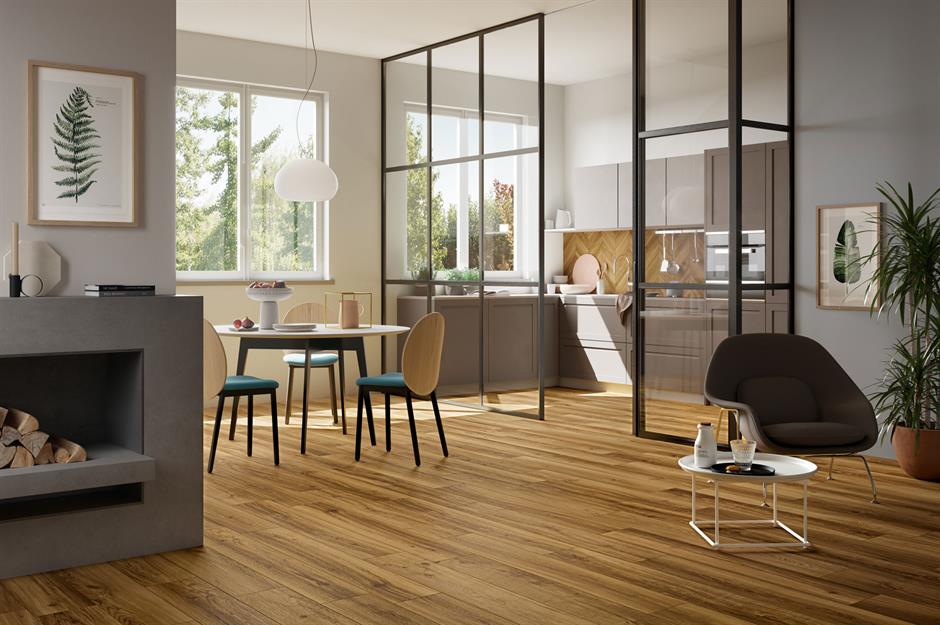
An open-plan living and kitchen area has many benefits but sometimes shutting off the kitchen whilst cooking is more practical. Glass walls create the best of both worlds; noise steam and cooking smells can be closed off without compromising on light or sense of space.
Unify alcoves
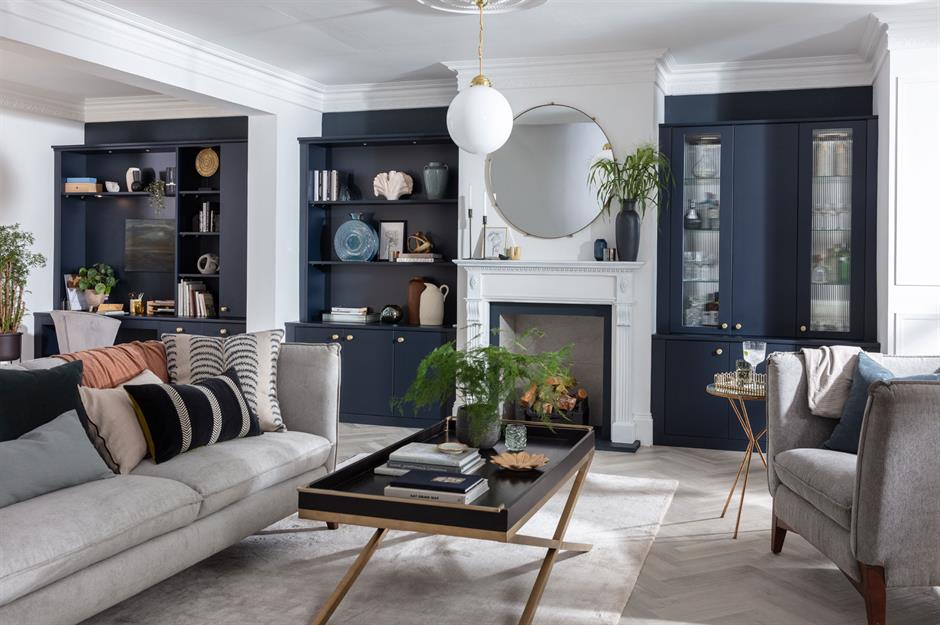
Make use of older property alcoves by building matching bespoke storage that knits newly knocked-through rooms together. Painted dramatic navy blue, these built-in bookcases blend seamlessly with a workstation behind the living area to keep the whole space coherent.
Open up with arches
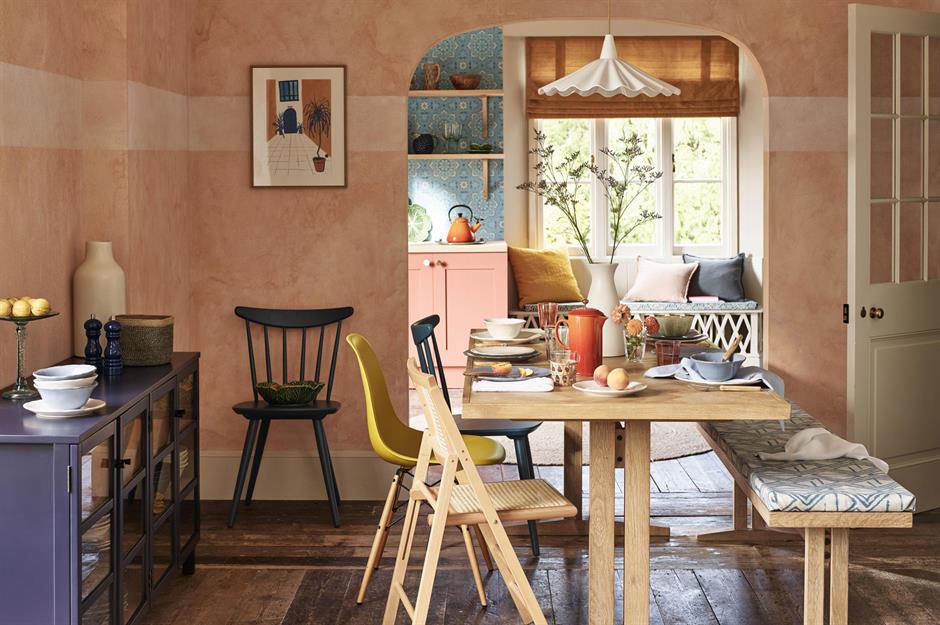
If you are at the planning stage of making your home open-plan, why not give the design a touch of architectural structure arched through ways? Curves are currently a huge trend and the contours will soften a space adding charming character.
Mix old with new
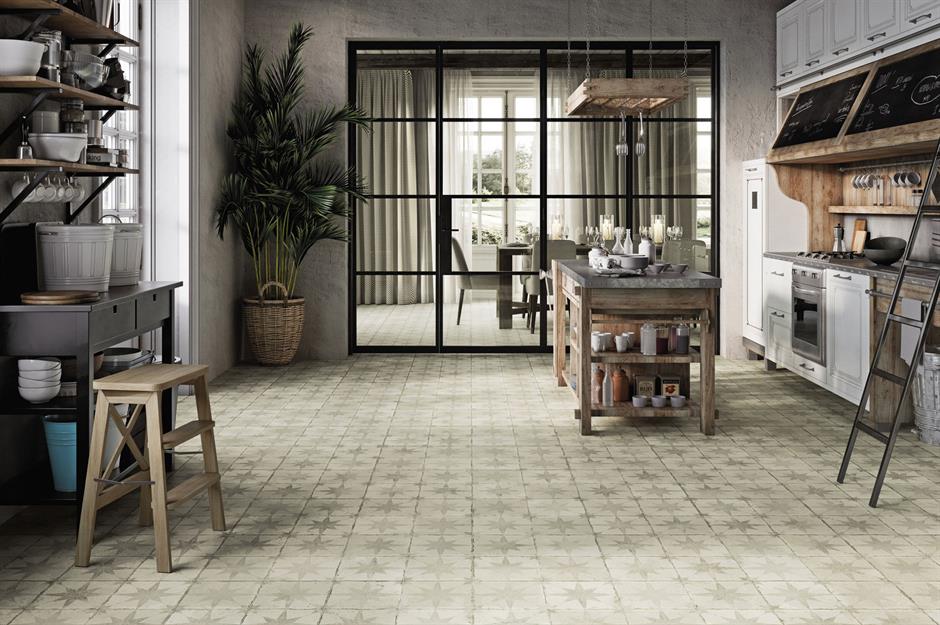
Give a large space character by contrasting zones with old and new décor. This spacious kitchen has been given farmhouse charm with heritage-style floor tiles and rustic cabinets. However beyond, behind modern Crittall-style doors sits a stylish and contemporary dining room that sets the ideal scene for a sophisticated dinner party.
Zone with wallpaper
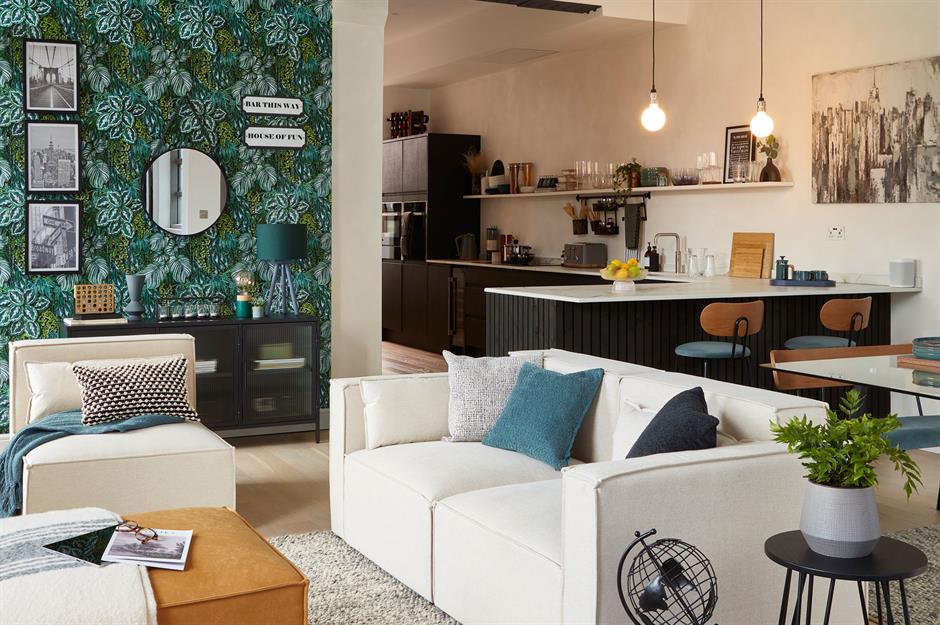
Give the living area of an open-plan room a homely atmosphere with an on-trend, wallpapered feature wall. Refreshing botanical-print wallpaper gives this small but neutral space a pop of pattern and colour that's perfectly in keeping with the industrial-style space.
Invest in smart storage
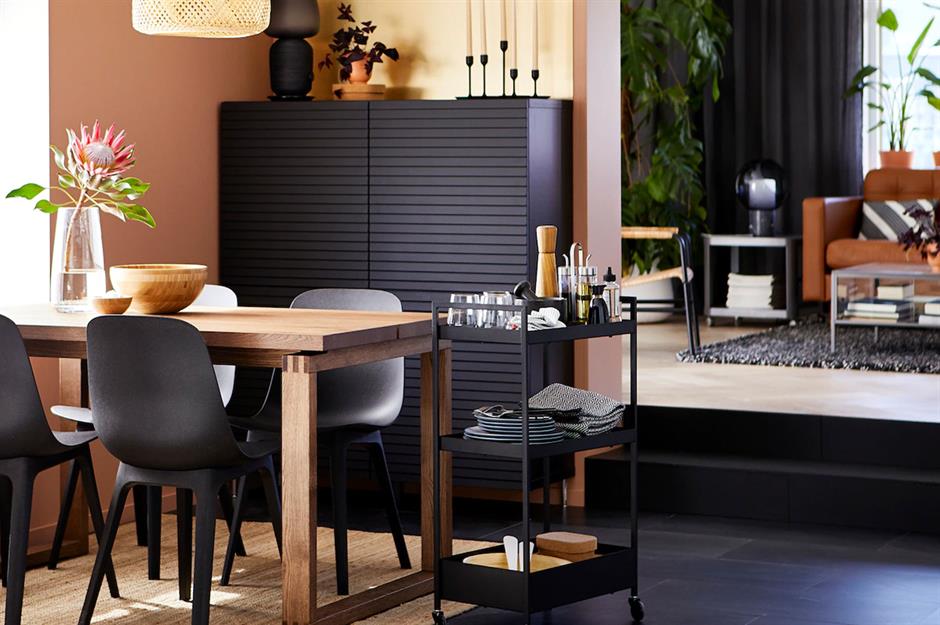
When using a large open-plan space for many uses clever storage will be a hero. Closed storage positioned perfectly will keep utensils and hidden but ready for use. This chic black, textured cupboards makes open-plan dining a doddle.
Modernise with a mezzanine
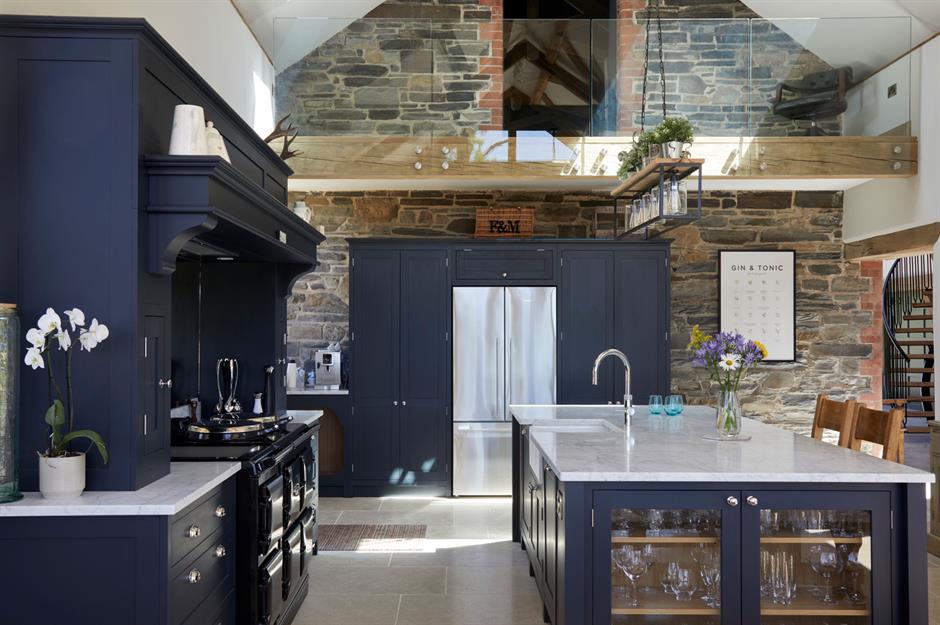
If you have particularly high ceilings or are converting an airy barn-style space, think about incorporating a mezzanine floor into your design. Whether used as a seating nook, library or study, it will allow you to create a more intimate room within your airy open-plan living area. In this scheme, translucent barriers add a contemporary feel while still allowing a seamless flow between the two levels.
Connect the garden
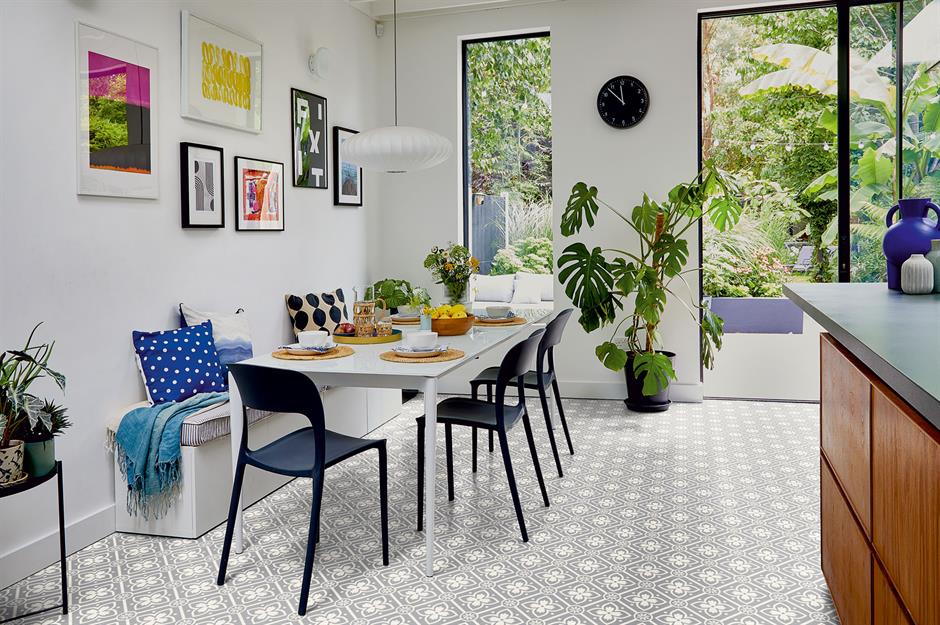
Glazing isn't just useful for drawing natural light indoors. By introducing floor-to-ceiling glass doors, you will open your living spaces up to the garden, creating a seamless flow. Your backyard will also instantly become an extension of your interior, enhancing the sense of space, adding usable inches to your home. Make the transition outside even more seamless by matching the internal flooring with that of your external patio.
Impart plenty of personality
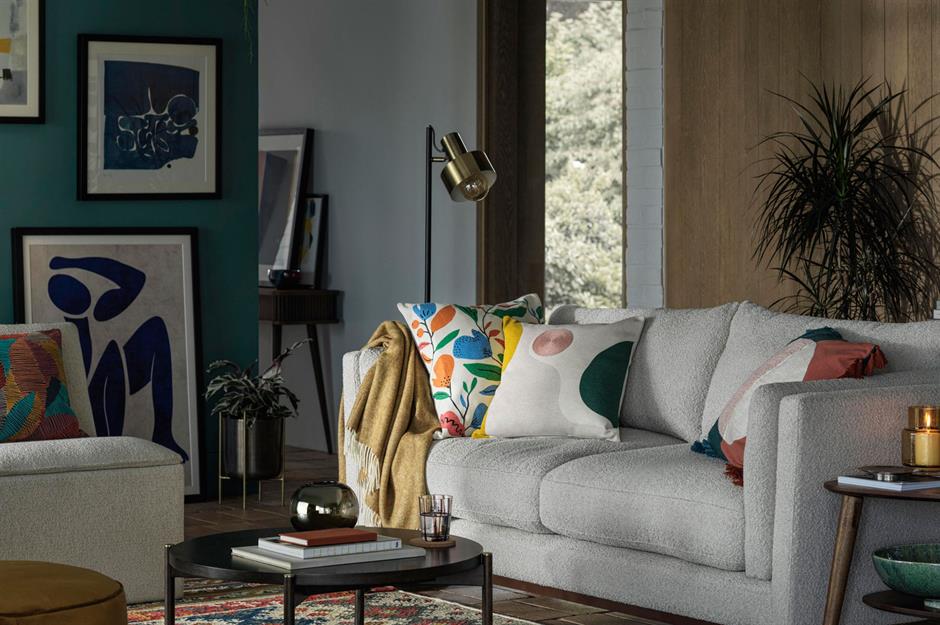
Large open-plan living rooms can lack character so adding personal objects will make the space feel homely. Rich teal creates an interesting base for this picture wall, creating a flexible focal point that anchors the scheme. Mid-century furniture and pops of mustard and terracotta add to the eclectic look of this inviting family space.
Divide with plants
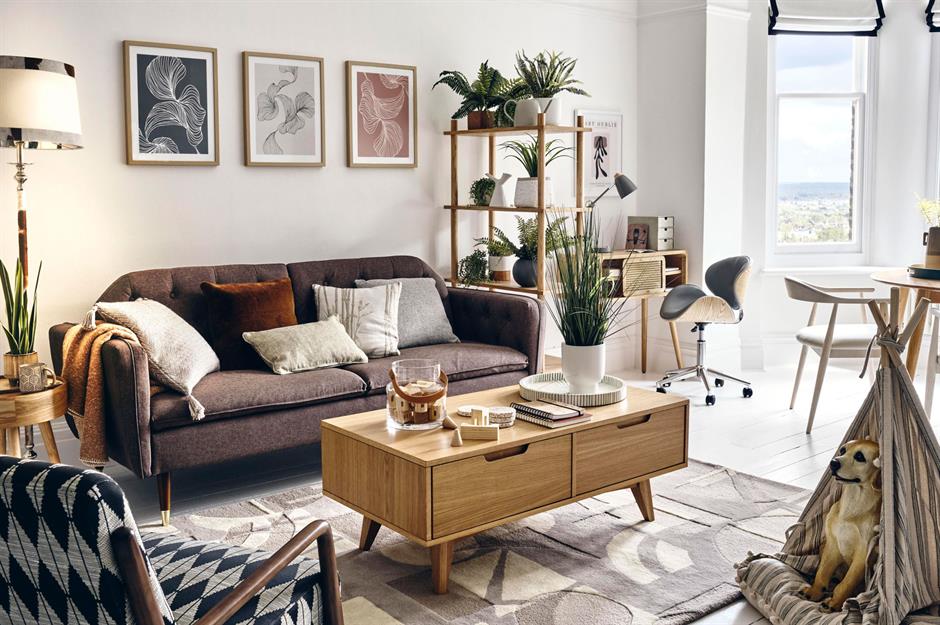
While accent colours can unify distinct zones in a large, open-plan room, they’re not the only tool in a decorator’s arsenal. If you’re more of a minimalist, instead of disrupting a crisp, clean scheme with superfluous hues, why not turn to Mother Nature instead? Vibrant foliage and houseplants are a great way to create a visual connection between different areas without compromising on a streamlined aesthetic.
Darken the walls
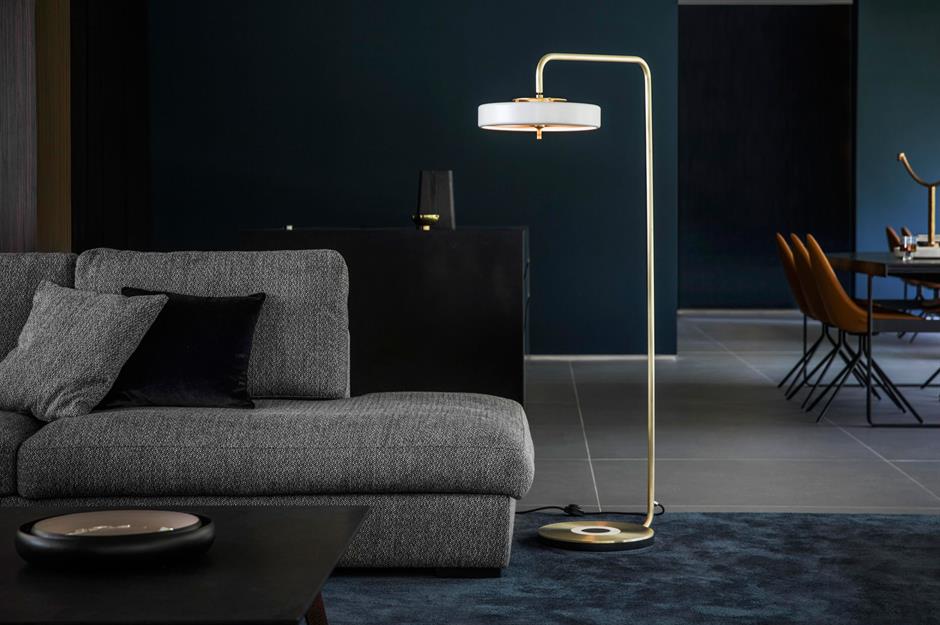
A large open space with plenty of light creates a fabulous canvas to experiment with colour. Dark paint shades will create a cosy and contemporary vibe when teamed with concrete-style flooring. Add to the ambience with feature floor lights and gentle spotlighting overhead to boost the moody atmosphere in the evening.
Embrace broken plan
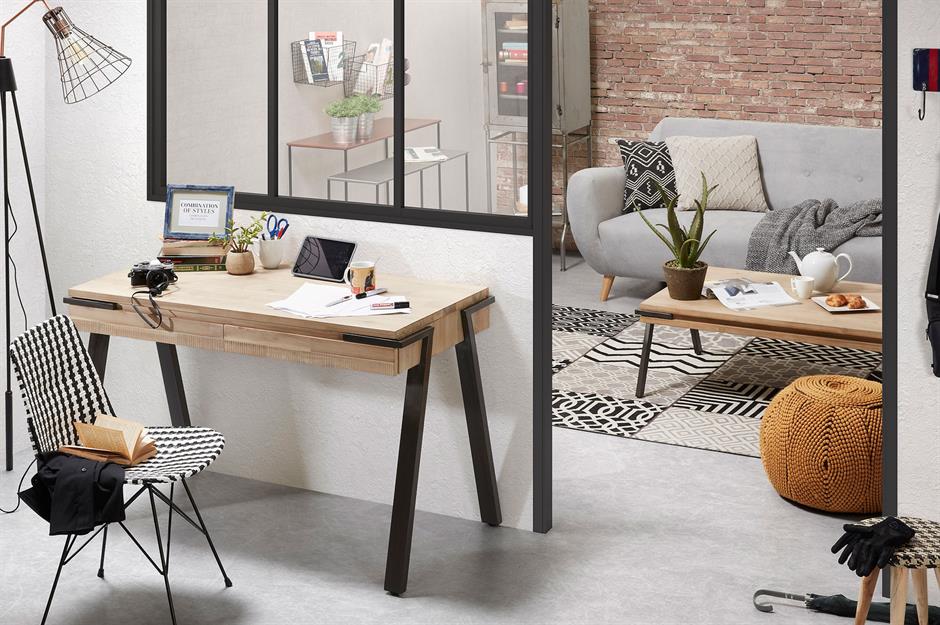
If a fully open-plan space seems too extreme, then a broken-plan layout might work better for you and your lifestyle. This semi-open floor plan allows you to break up a large living area with room dividers, furnishings or accessories. You can use this technique to define different zones for different tasks to help you make the most of every inch of space.
Sink a space
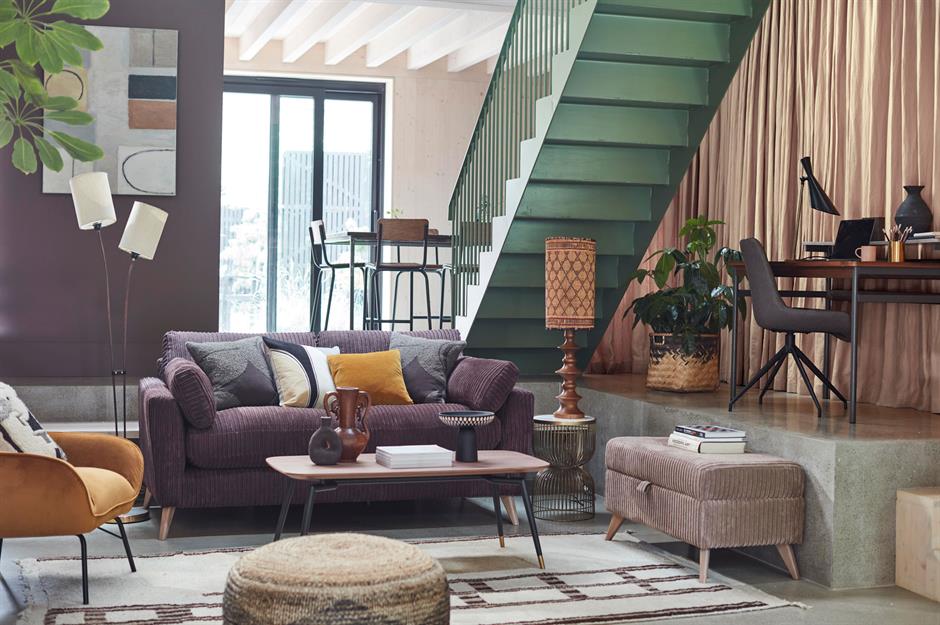
If you prefer modern open-plan living spaces with no walls or room dividers, there are other ways you can create a subtle distinction between functional areas. In this light-filled multiuse room, the sleek kitchen and dining area sit at floor level, while the floor has been lowered to create a cosy sunken TV area—a modern take on a mid-century conversation pit.
Bring in a barn door
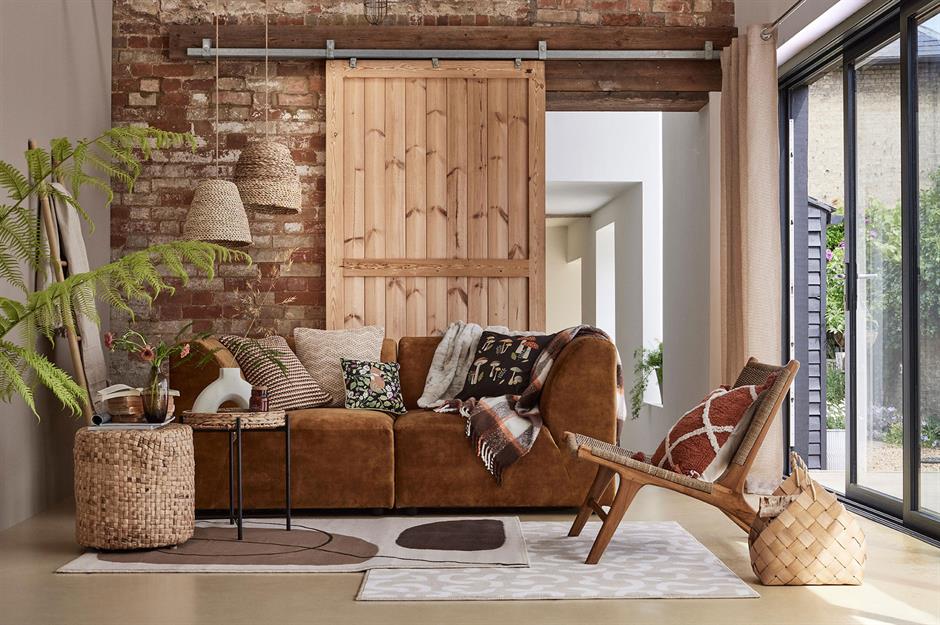
Give your open-plan living space a rustic touch by installing a barn door. Sometimes a little privacy might be needed, so sliding a barn door into place as a temporary divide between zones is an on-trend solution—just the ticket for a cosy movie night or an intimate dinner.
Go dramatic
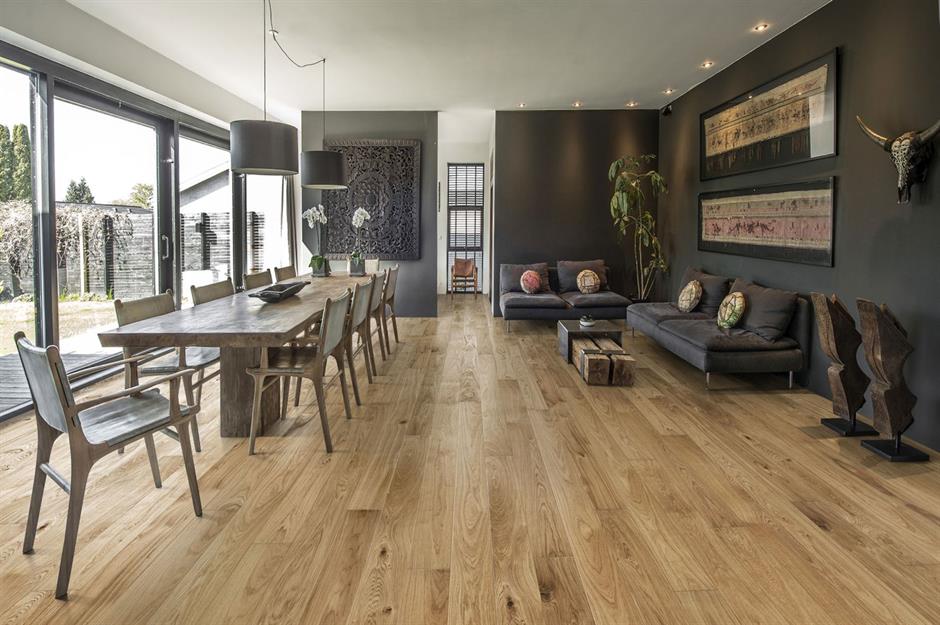
A large open space with plenty of light creates a fabulous canvas to experiment with colour. Dark paint shades will create a cosy and inviting vibe when teamed with warm oak flooring. Add to the ambience with pendant feature lights and gentle spotlighting overhead to boost the moody atmosphere in the evening.
Plan it out in advance
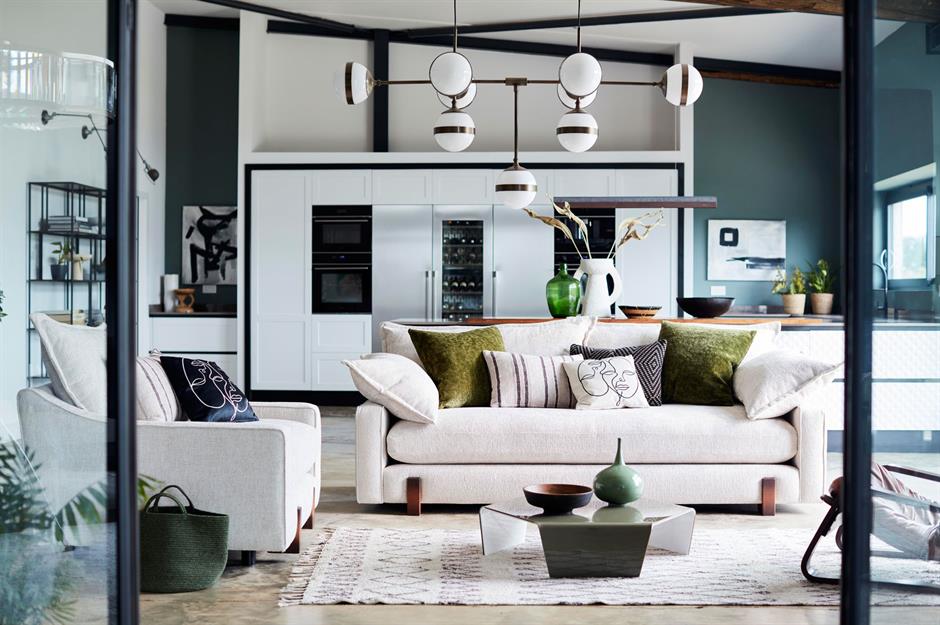
A great way to ensure an open-plan layout will work for you is it plan out furniture placement in advance. If you're planning on moving to an open-plan home, or you're renovating your current property, then sketch out room layouts and map out where your furniture and zones will go. If you already have access to the space, use masking tape on the floor to represent each piece of furniture. This way, you'll be able to see whether each item will fit and how the rooms will work together.
Design around your daily needs
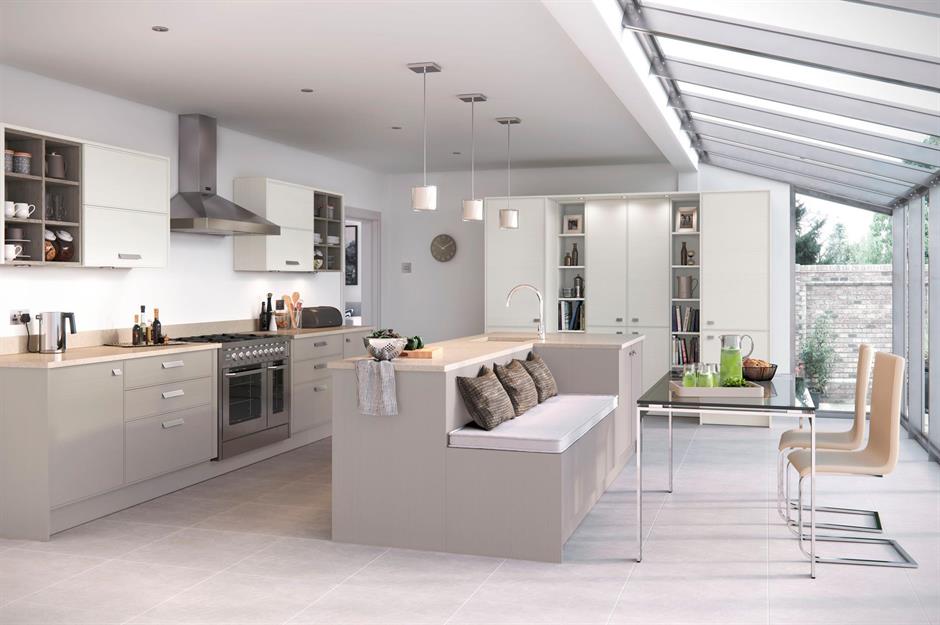
Before you begin creating your dream open-plan interior, take a moment to consider how you will use it from day to day. Do you want to make the ultimate entertaining space or a relaxing haven for cosy nights in? An open-plan layout can add real wow factor to a home, but remember that the space has to work for you and your lifestyle, too. Understand your main needs and think about how many people will be using each space and for what purpose.
Don't neglect soundproofing
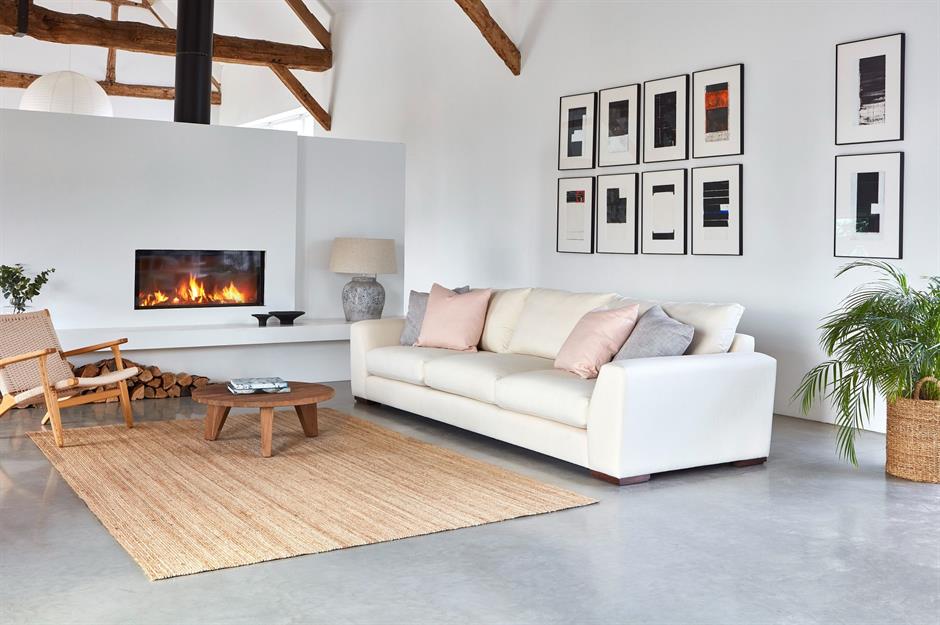
Open-plan living is great, but by removing walls privacy is reduced and noise is amplified. Therefore, soundproofing is the key to a successful design. Opt for soft flooring to minimise noise and incorporate plenty of soft furnishings like heavy curtains and cushions to absorb sound, especially if you have high ceilings that can amplify noise.
Reinvent a period property
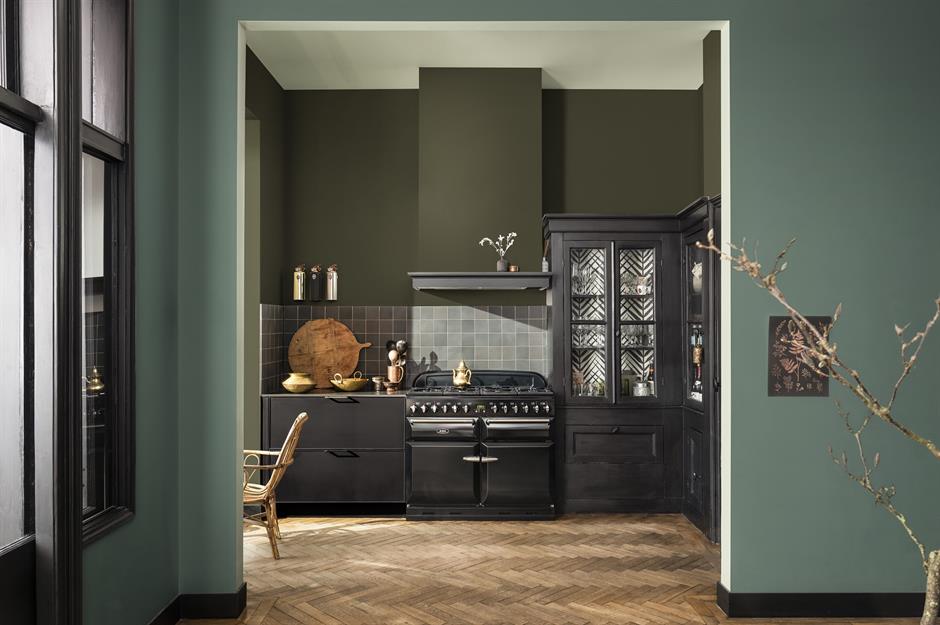
Open-plan isn't just for modern homes. In fact, opening up a period property can add serious wow-factor. Often, rooms in older homes can feel dark, dingy or cramped, so knocking through to open rooms up can be a great way to add practical living space, value and natural light. You can even open up doorways to create a seamless flow without knocking down walls. Before undertaking any work, be sure to look into planning permission and permitted development rules.
Design around your dimensions
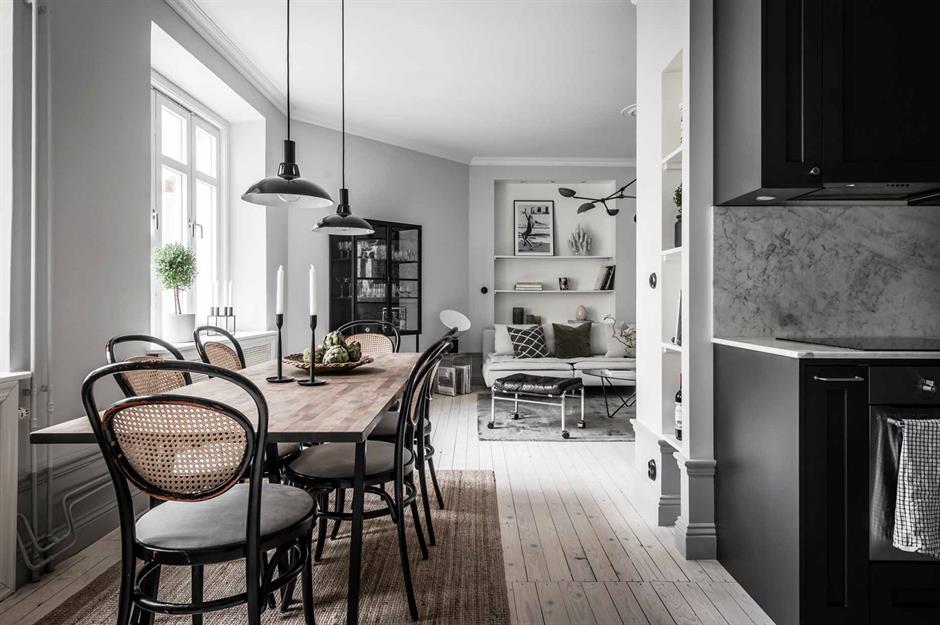
Not every multifunctional living space is square or rectangular—instead of trying to make your room fit into a formulaic open-concept layout, embrace unusual dimensions and create a design that works with the eccentricities of your space. In the U-shaped floor plan of this Scandinavian loft from Alvhem, a long dining table fits snuggly in the thoroughfare between the kitchen zone and the lounge.
Bring in a bold contrast
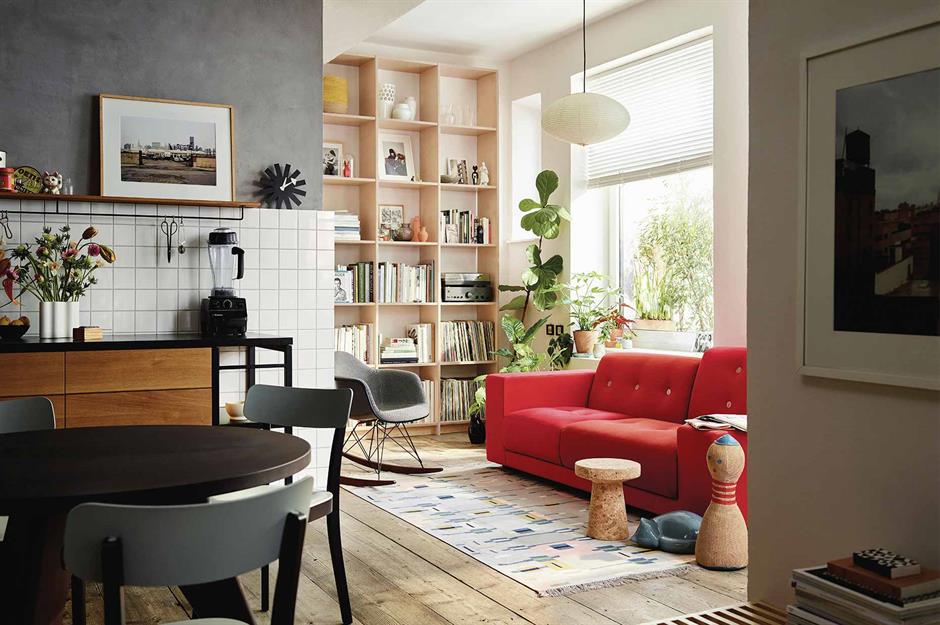
If you want to create carefully defined living areas within a free-flowing space, don’t be afraid to give different functional zones radically different personalities. In this contrasting scheme, the kitchen features moody grey plaster-effect walls, dark wood furnishings and coordinating appliances. Meanwhile, the adjacent lounge offers a completely different ambience with its bright white walls, light pine shelving and colourful statement furniture.
Slip in storage
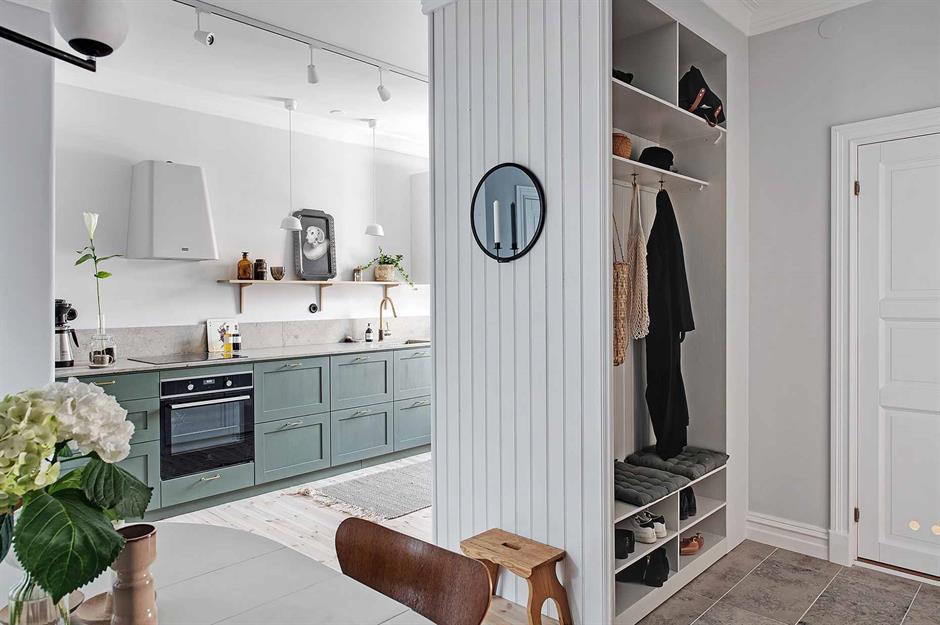
Don’t be afraid of squeezing more functional zones into your open-concept layout. This compact room divider has been fitted with coat hooks and shoe cubbies, as well as higher shelves for bags and accessories. Not only does it add valuable storage space, but it helps define the transition between the kitchen and dining area in this snug multipurpose room too.
Make lighting striking
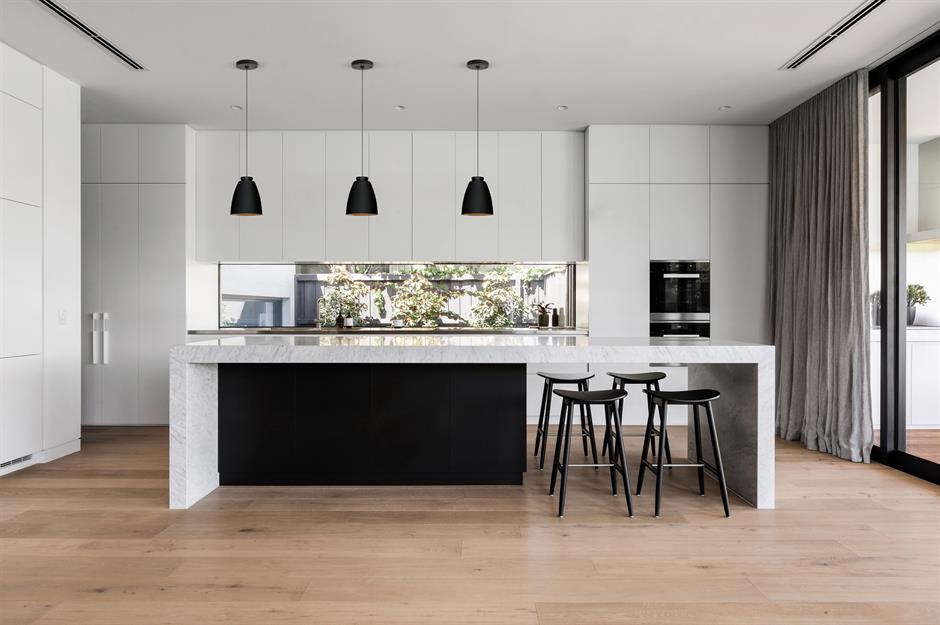
Consider how you're going to light your space right from the get-go in order to plan for the electrical wiring and sockets required. Options include stylish pendant lighting to illuminate a kitchen island, a cluster of pendant lights over a dining table, downlighters over the worktops and brighter spots that can be dimmed in your main lounge area.
Unify with a theme
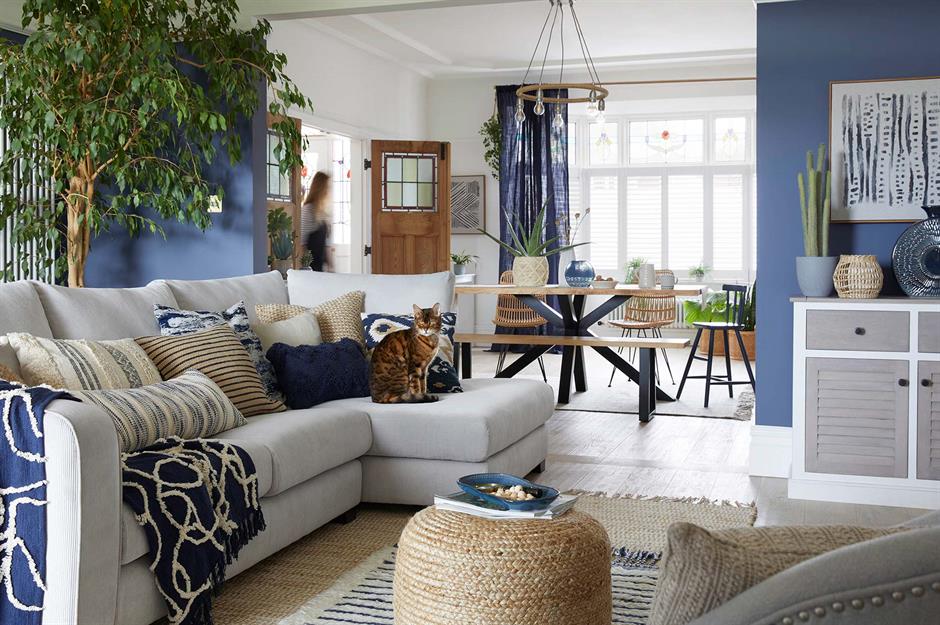
Create a cohesive look in a large, multiuse space by embracing a unifying theme. Here, a subtle coastal scheme works hard to tie together the living room and dining area. Deep blue walls and furnishings create a visual connection and draw the eye through the adjacent spaces, while jute and rattan accessories complete the harmonious feel.
Add a double-sided fireplace
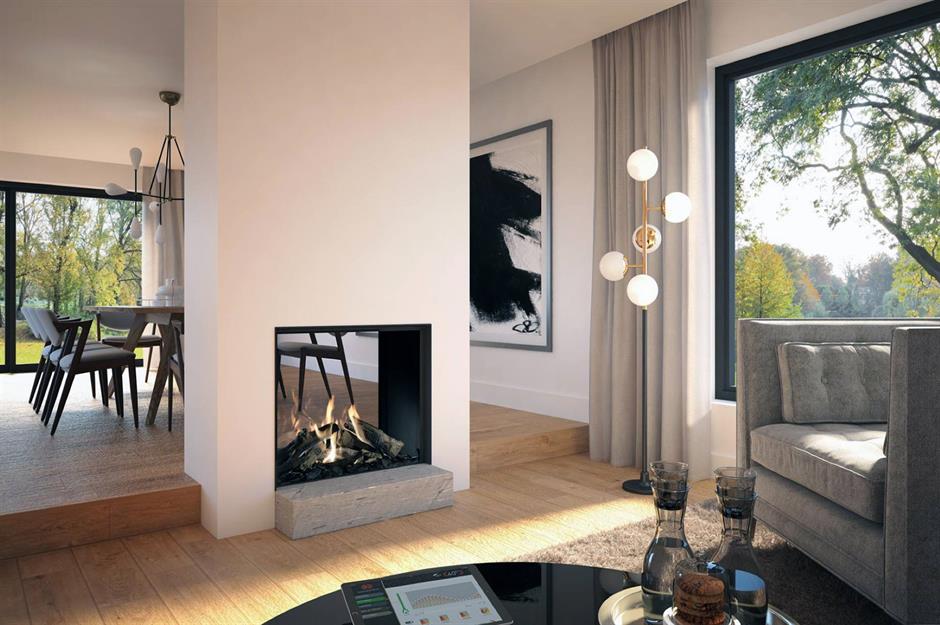
Try to give each distinct area of your room its own focal point. In the kitchen, it could be the island unit or the range cooker. In the dining space, it might be a dramatic pendant light. In the living area, a fireplace is ideal. Here, a fireplace has been built into a small partition wall between the dining and living space for a designer look. And, if you thought you needed a chimney for a fireplace, think again: the latest bio-ethanol fires don't require a flue and can be placed anywhere.
Keep thoroughfares clear
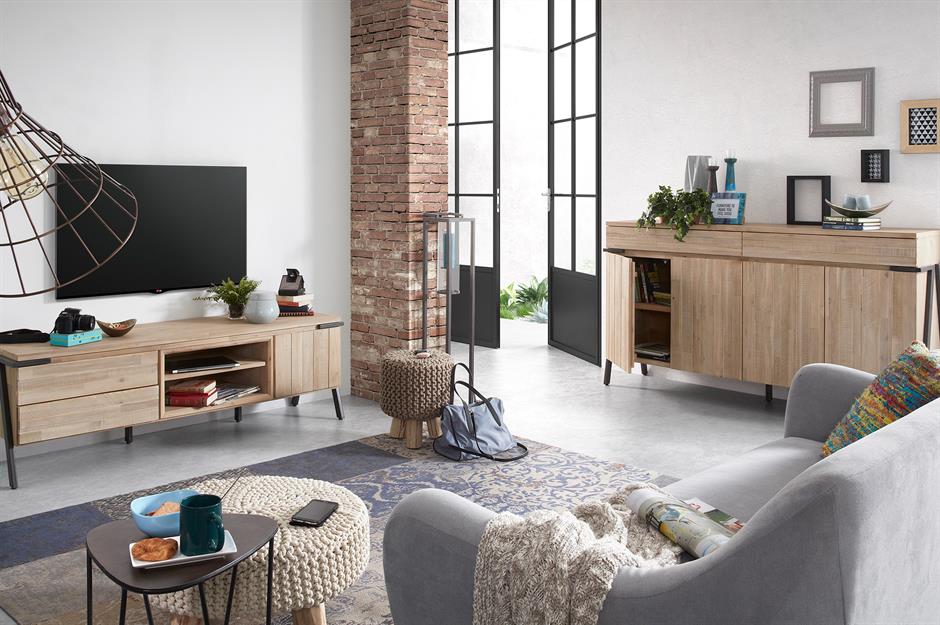
Add a corner sofa
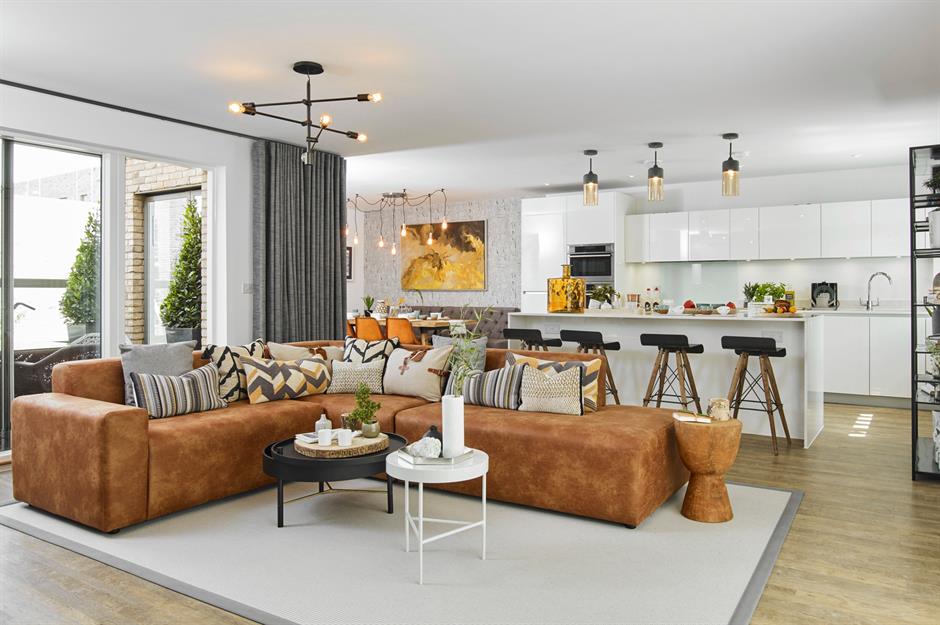
While there are so many styles of sofa to choose from, a large corner or L-shaped sofa is a great way to zone off your lounge in an airy open-plan space. For something practical and durable, go for a tactile family-friendly fabric like leather. An inviting focal point, complete the relaxed vibe with a rug, coffee table and plenty of soft cushions.
Don't overlook heating
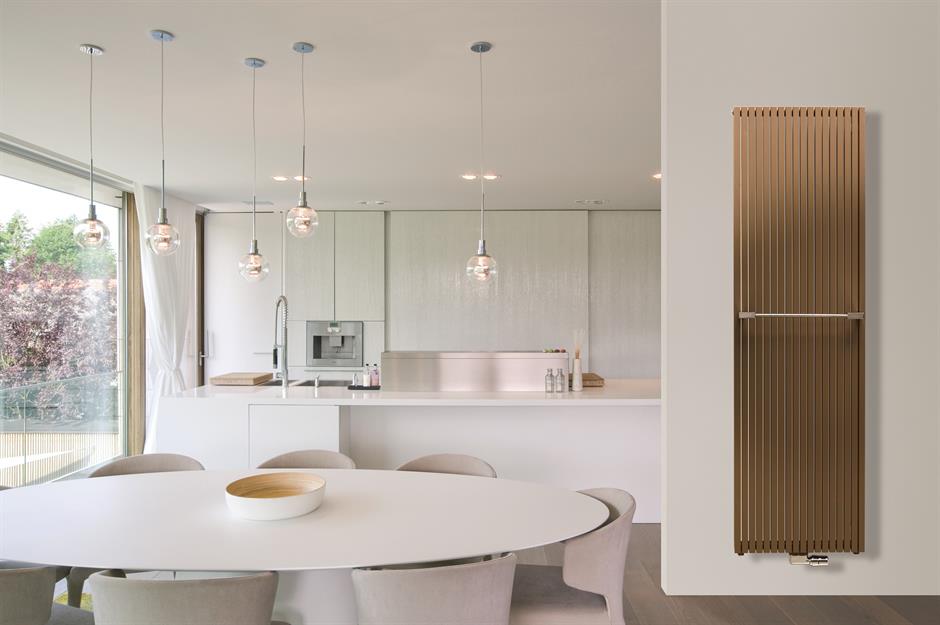
It goes without saying that due to the lack of walls, open-plan living rooms can become cold and drafty quickly. Many homeowners overlook the fact that a single radiator is powerful enough to warm a closed-off space, but not a large, open room. So, before you knock down walls, hire a heating engineer to check whether your current boiler and radiator set-up will be enough to heat your home. You may need to consider extra heat sources, such as underfloor heating, which could increase your energy bills.
Turn up the texture
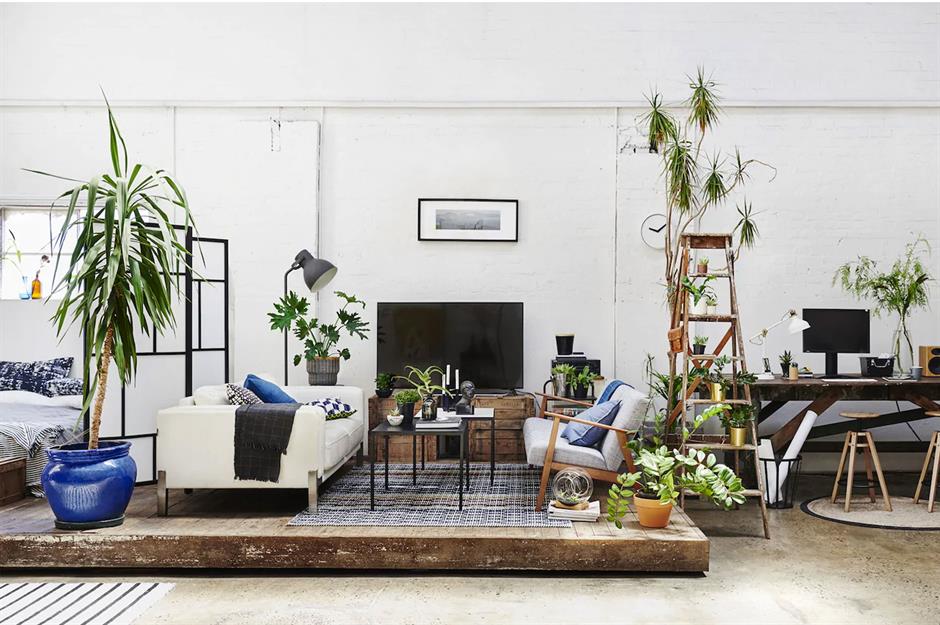
If your open-plan room was originally designed for a use other than living in, it might require a little bit more softness and comfort to make it a space you'll want to spend lots of time in. Make sure it has plenty of homely character by using natural elements such as wood flooring, textured soft furnishings and lush houseplants. Add cushions to sofas, go for long drapes and layer rugs to make it cosy and inviting.
Make walls mesmerising
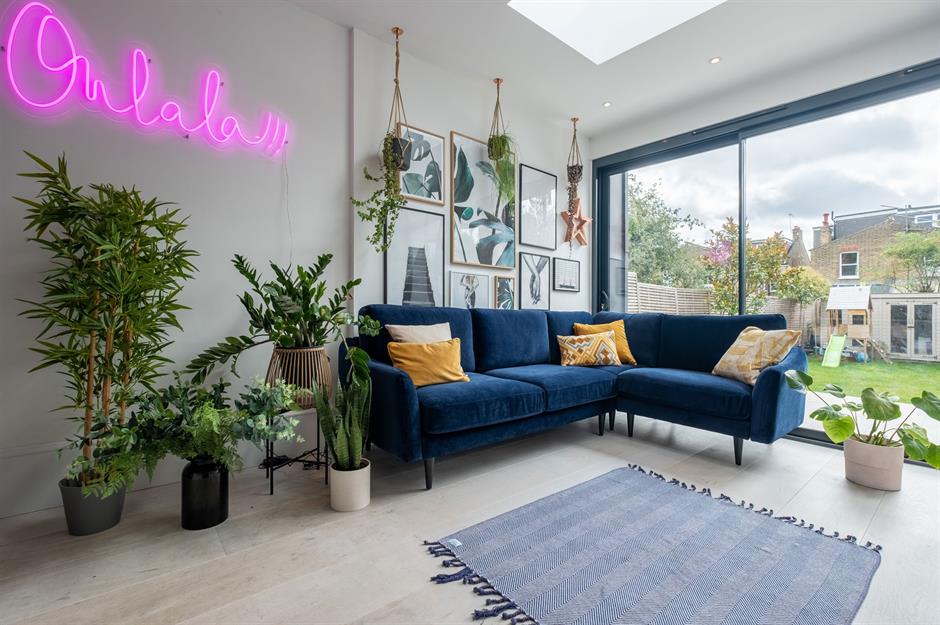
Use wall art to visually divide open-plan areas into discreet zones. Gallery walls with family photographs will personalise your living areas, whereas neon wall lighting looks quirky and adds atmosphere to dining or home office areas.
Partition with glass
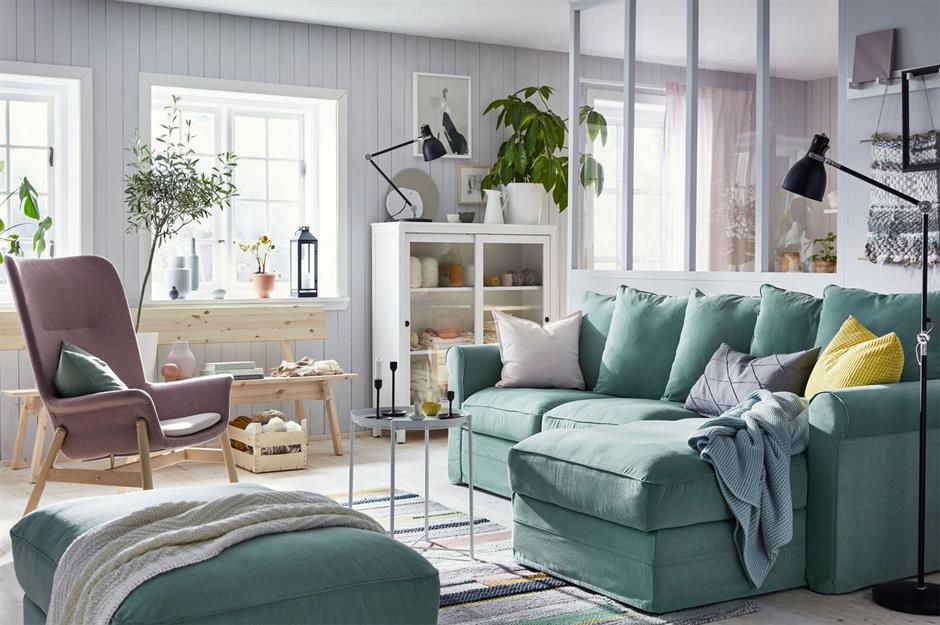
Sliding glass doors or panels are a very effective way of dividing an open-plan space into smaller zones while ensuring plenty of light flows through the entire area. Here, a dividing wall has been half-glazed with panels to separate the living area from the kitchen-diner without the space feeling like two disconnected rooms.
Impart flexibility with pocket doors
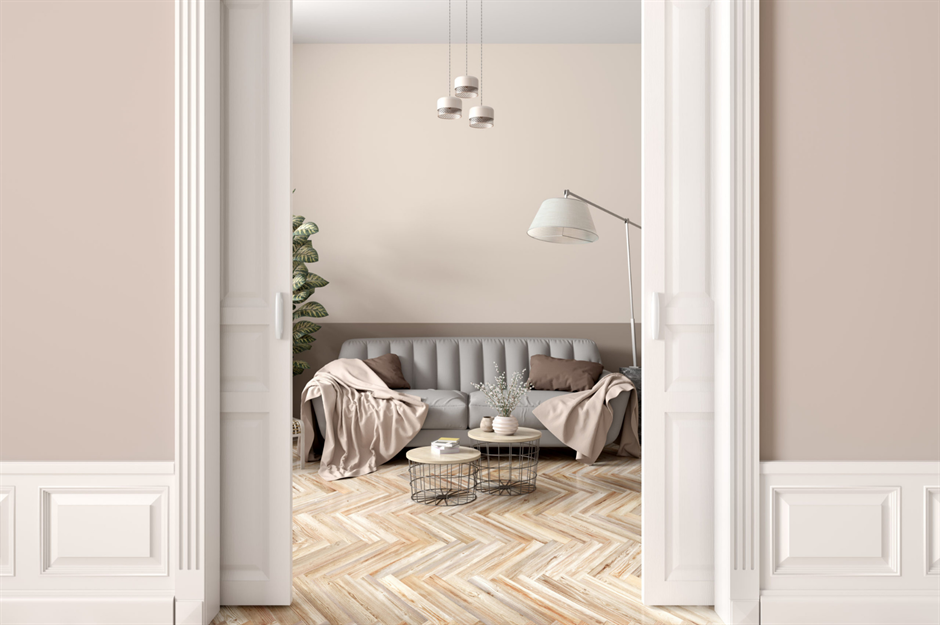
If you don't like the idea of using internal glass, there are some alternatives that will allow you to impart flexibility into your open-plan design. Sliding pocket doors, which literally disappear into niches in the wall, will enable you to open up spaces when you want to, and close them off again whenever the need arises. This approach is particularly useful for those with children, as it means you can create zones, increase privacy and reduce interior noise flow.
Slot in an eating space
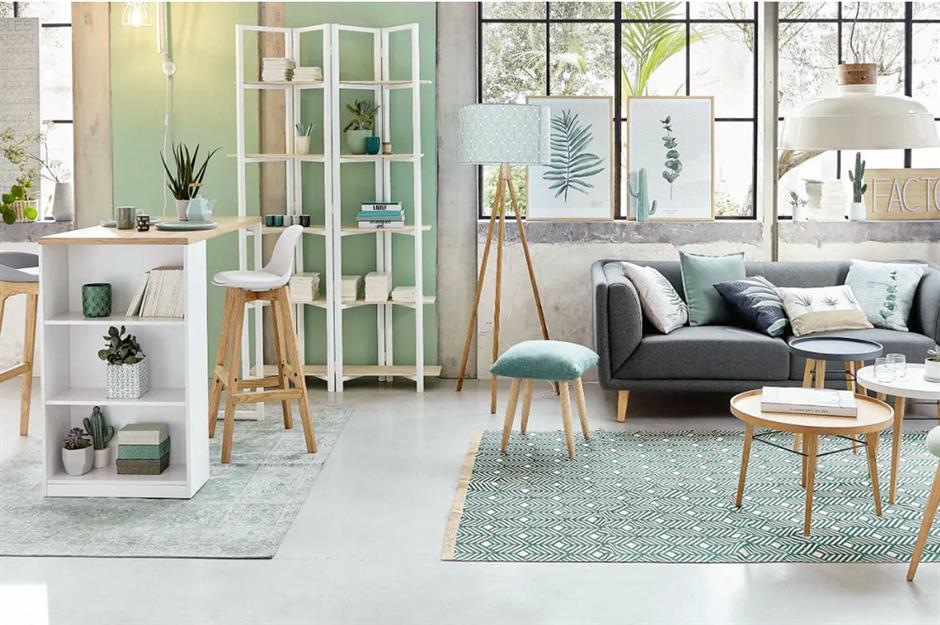
Make furniture multifunctional. The slimline design of this bistro-style bar table is perfect for a quick meal and also makes good use of space by separating the kitchen from the living room in a small area. This one has extra storage shelves on the side to keep tableware. It can then be easily moved to the side of the room when more floor space is required.
Zone with furniture
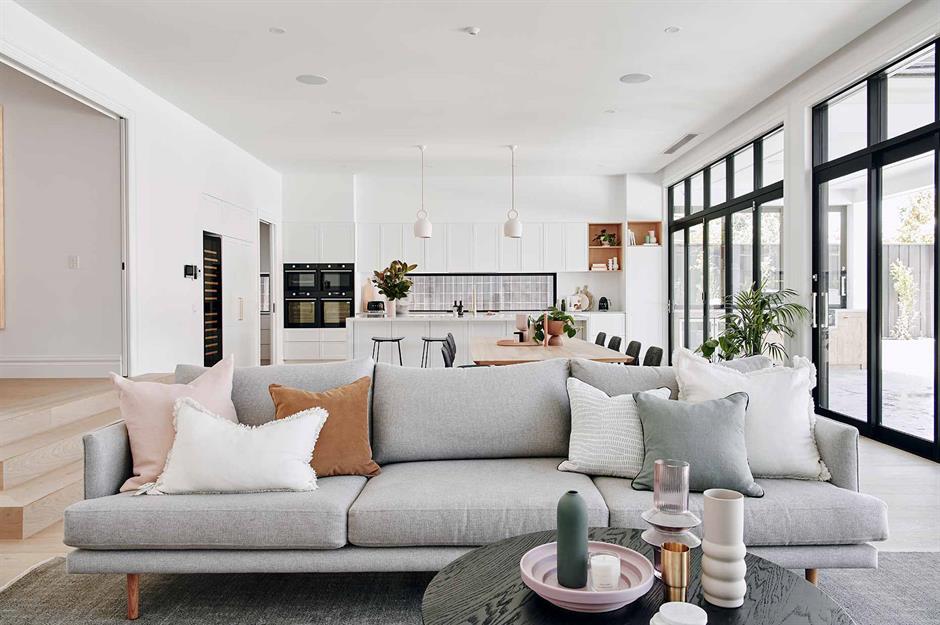
Use furniture to zone off an airy open-plan space in need of structure. This modern living area is divided into thirds thanks to carefully arranged fixtures—the breakfast bar separates the kitchen and dining zones, while the sofa creates an intimate seating nook that’s distanced from the busy culinary space.
Choose an L-shaped layout
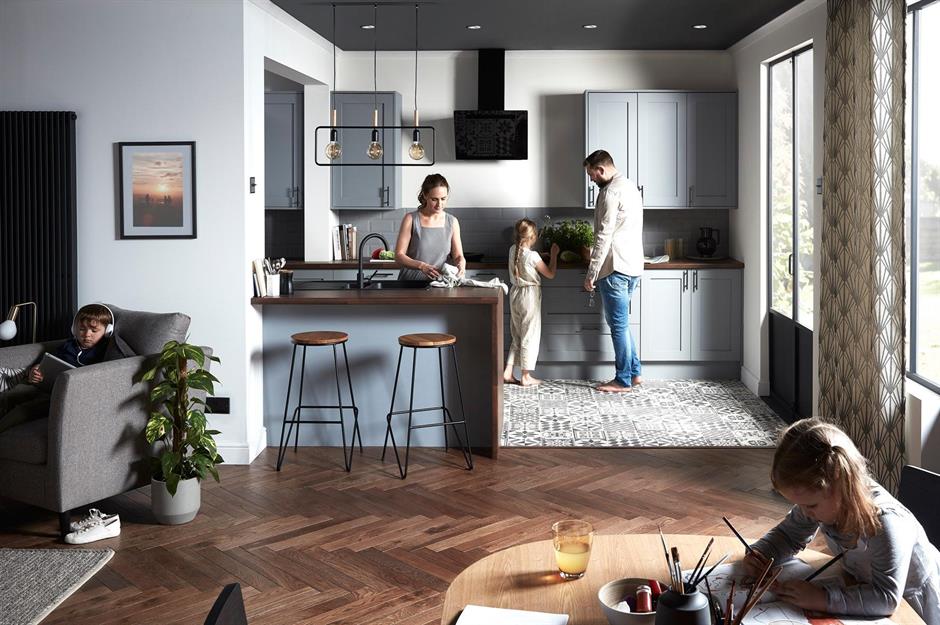
If you're extending your home or knocking down or repositioning walls to create a whole new open-plan space, think about making it L-shaped. It's easier to break a room up if it isn't a standard square or rectangle shape. An L-shaped room will allow you to create a hidden eating or sitting space in a corner—this layout tucks the kitchen neatly away when required.
Make the stairs the star
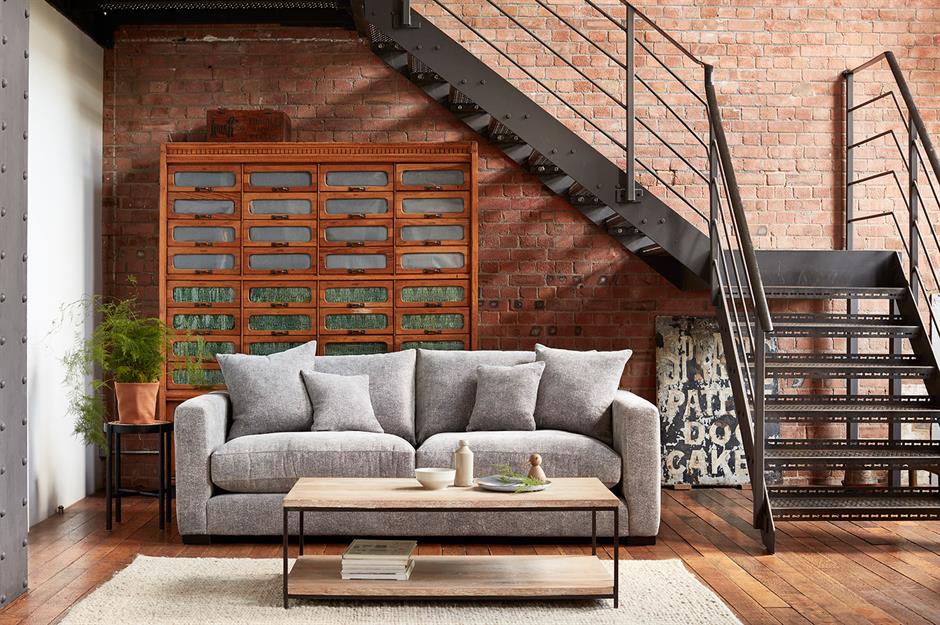
Stairs can add a striking architectural feature to open-plan rooms. This industrial-style open-plan living room has a rustic vibe thanks to the factory-style iron staircase and exposed brick wall. The apothecary drawers and metal coffee table bring the whole look together.
Make the staircase disappear
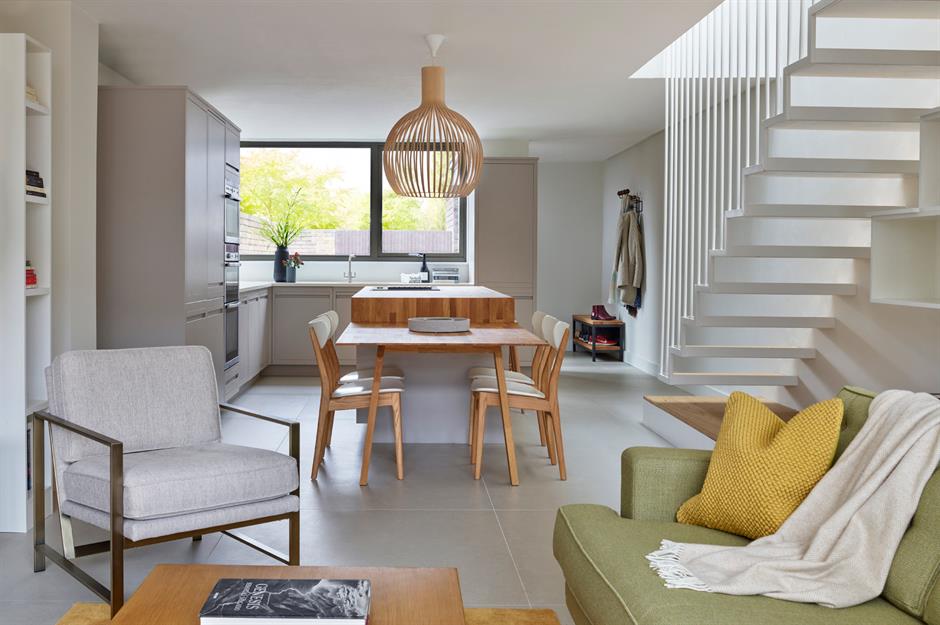
At the other end of the scale, if you prefer your staircase to blend into the backdrop paint the steps and banister the same colour as the walls. Here, this minimalist staircase has open risers and a ceiling-hung balustrade so it appears to float in the room, offering a stylish and space-saving addition to this contemporary open-plan living room.
Choose a monochrome palette
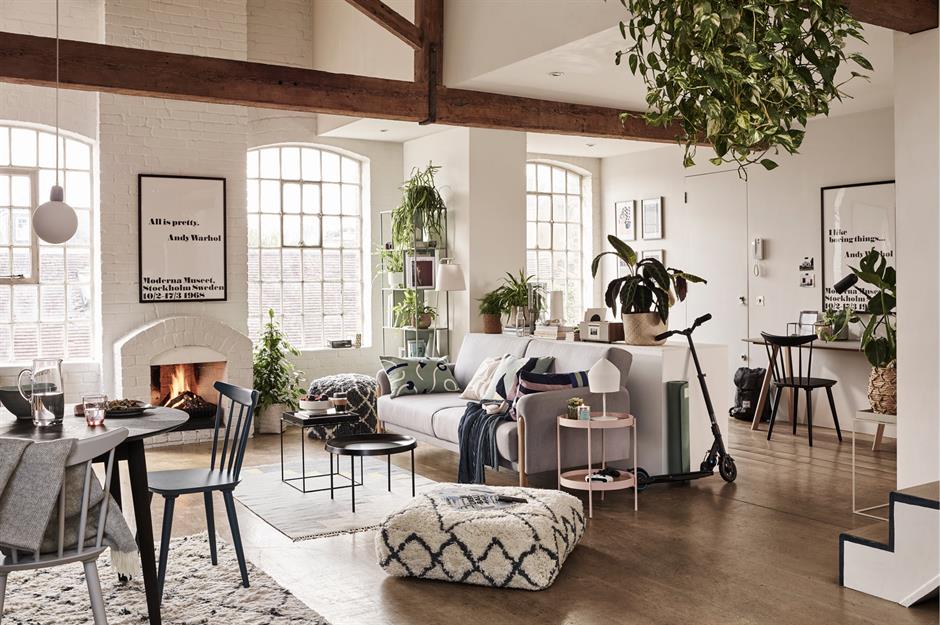
When it comes to the heart of the home, living rooms are overtaking kitchens so a stylish open-plan communal space that provides room for relaxing, working, exercising and dining is the key to success. This industrial-style open-concept room uses easygoing modern furniture, cosy texture and lush greenery to make it homely. The large space is then pulled together with black accents and a soft white palette.
Add a privacy curtain
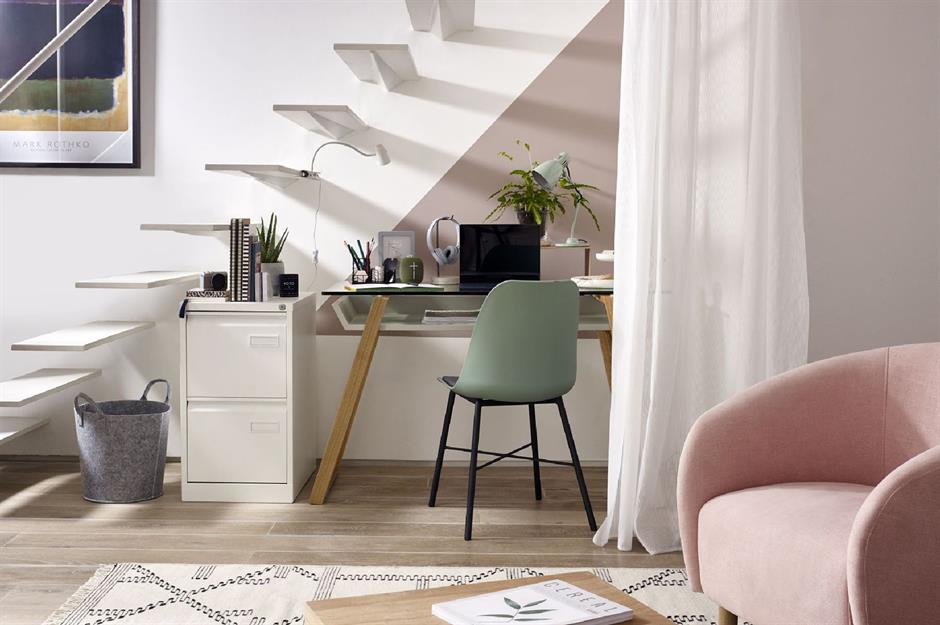
Create a coherent backdrop
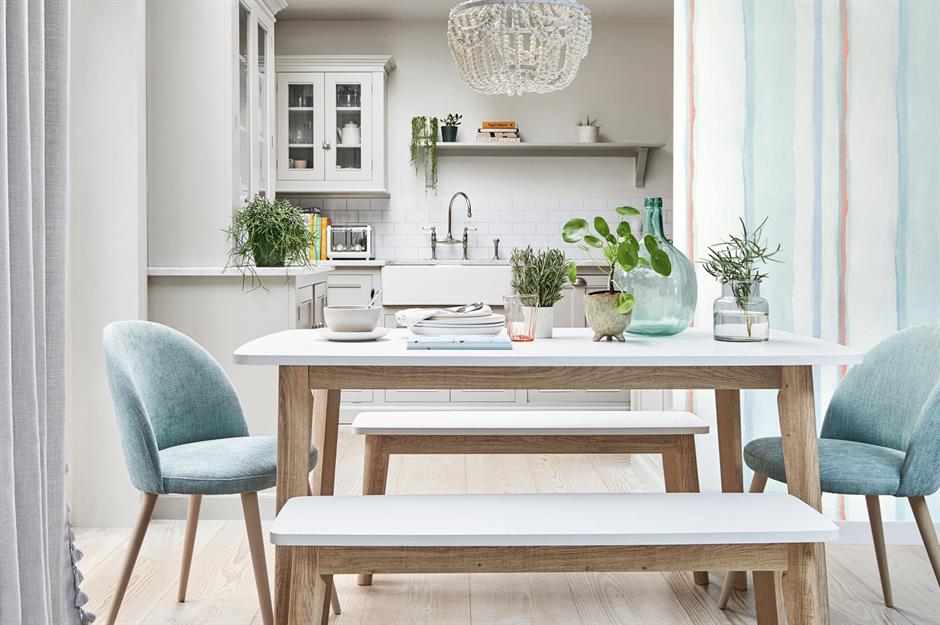
Help create a flow in a small open-plan space by making sure the backdrop is predominantly the same colour. Here, walls, kitchen cupboards and furniture are variants of the same tone to make the room feel spacious and cohesive. Two statement chairs and a panel of wallpaper add pretty and subtle interest.
Utilise the side return
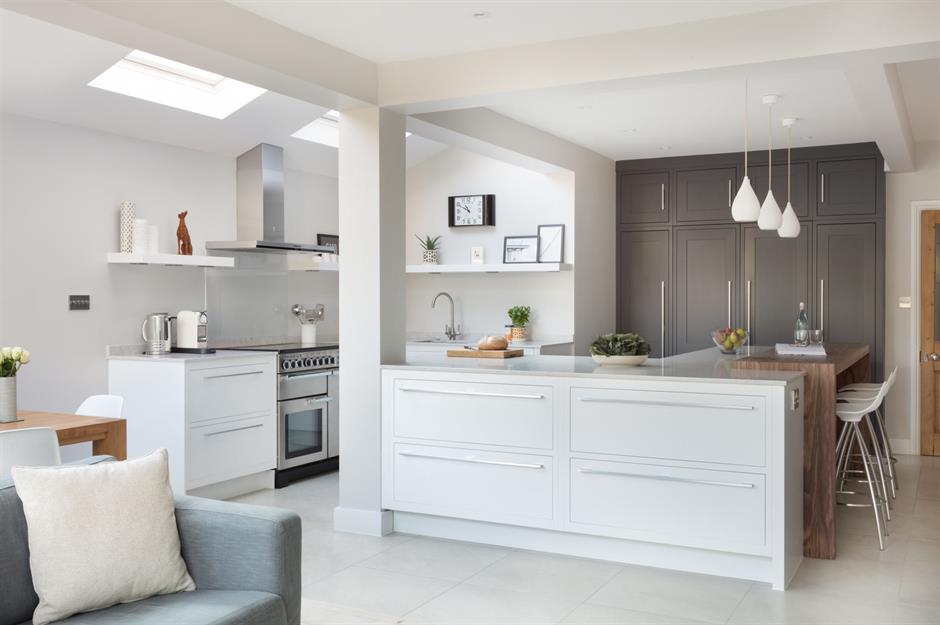
A small expansion such as a side return extension will enlarge an open-plan space to accommodate a kitchen-diner and living space in one. It's a popular route to open-plan living in older homes—if your home is dark, opt for a skylight in the ceiling to flood the space with light.
Make walls two-tone
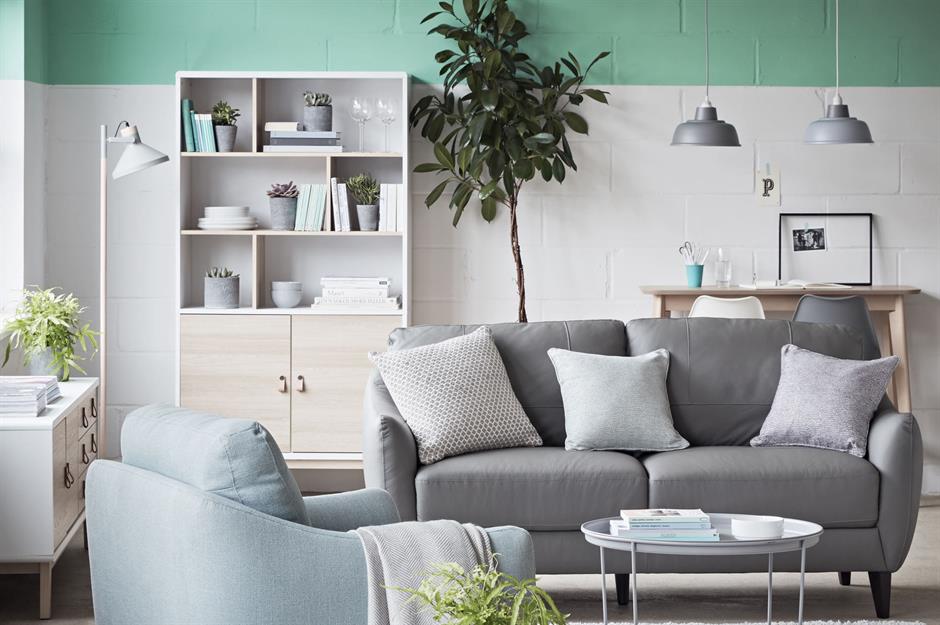
Unify a small open-plan living room with an on-trend paint technique. When space is tight, look to the upper portion of the walls and the ceiling. Paint this upper area a refreshing shade to make a statement across the entire room. Choose crisp white for the lower parts of the walls to create contrast; it will also reflect the light and maximise the feeling of space. Blonde wood and white furniture set against the walls add to the vibrancy of this invigorating room.
Bring in bookcases
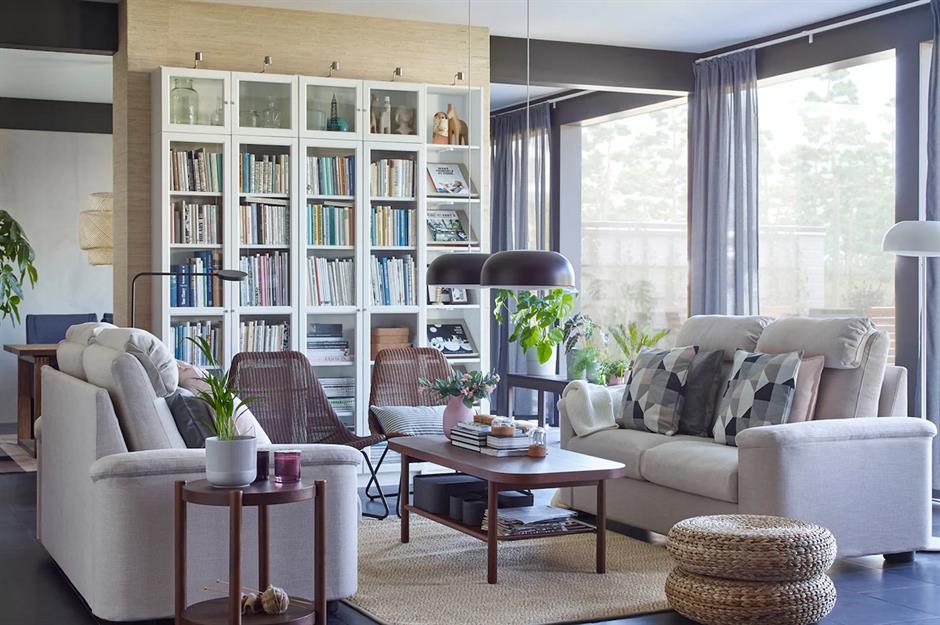
Open-plan living rooms with floor-to-ceiling windows are usually light-filled and airy, however, storage space can become tricky. One solution is to place back-to-back bookshelves in the centre of the room as a divider. Glass doors will keep colour-coordinated books dust-free and why not install ambient lighting on top to create an atmospheric evening glow too?
Maximise natural light
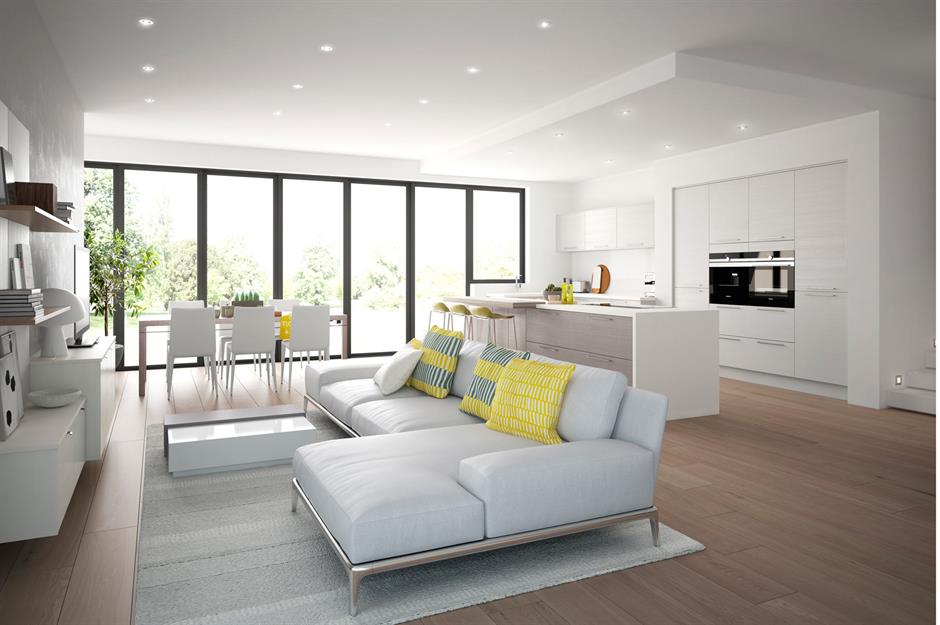
Before planning your open living zones, think about natural light sources. The brighter a room, the more inviting and spacious it will feel. To maximise light flow and create a stylish indoor-outdoor living space, install large floor-to-ceiling sliding, bi-folding or Crittall-style glass doors.
Play with paint
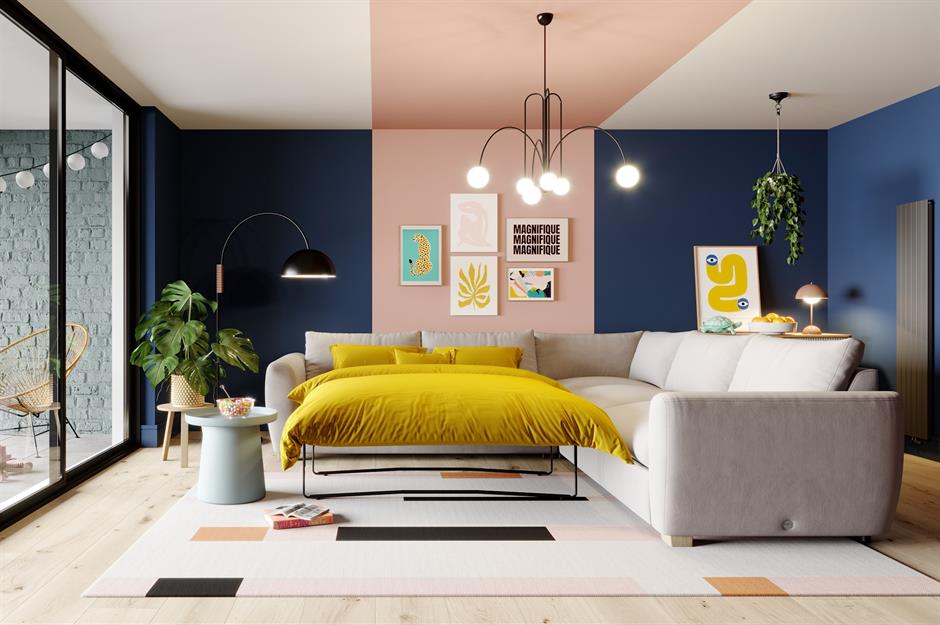
A bold feature wall makes a striking addition to a home and creates a clear visual link between adjacent living areas. Painting the walls opposite each other the same hue can elongate a small space, while a strong focal feature can really add wow-factor.
Zone functional areas with flooring
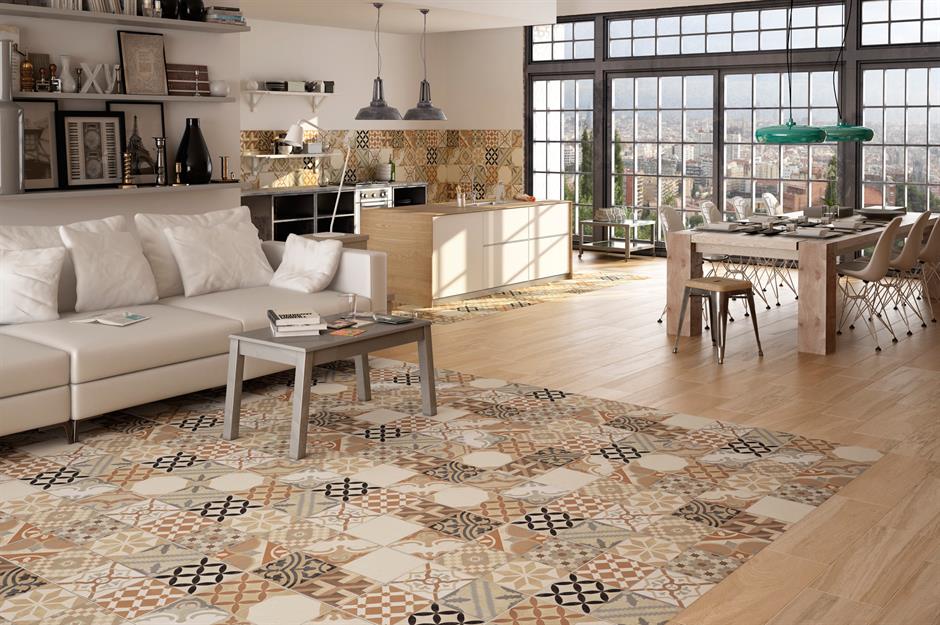
A larger open-plan space allows you to be more creative with your flooring options. It's possible to mix and match different types of flooring to help separate living zones, as long as the flooring types complement each other and create a cohesive flow. Here, porcelain tiles have been used in the kitchen area, blending into warm wood floors elsewhere. The patchwork-effect floor is then repeated in the central space to define the living area.
Dine around a circular table
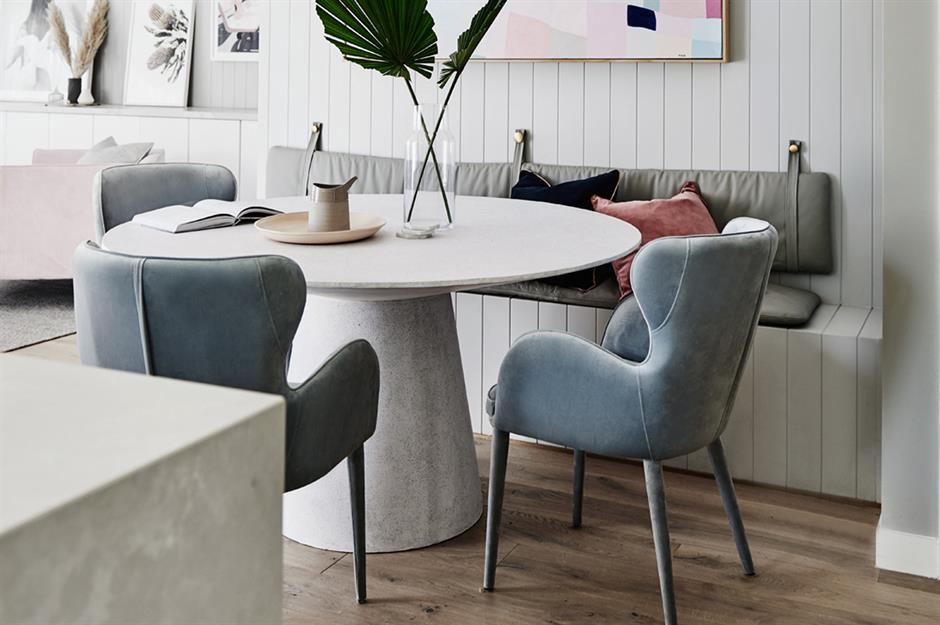
Narrow open-plan rooms will benefit from swapping out a standard dinner table for a round design. The curved edges take up much less floor space, creating a mini kitchen-diner in an especially snug area. Here, a built-in bench allows the table to sit towards the side of the room to allow plenty of passage for through traffic.
Create cohesion with wallpaper
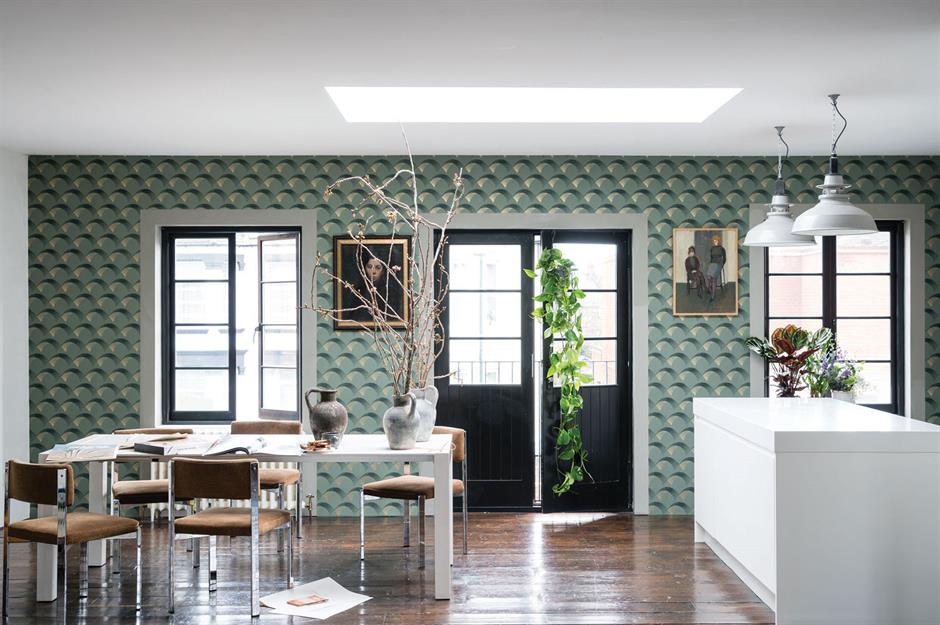
If your multiuse space feels unharmonious and disjointed, a bold design choice can be the unifying element you need. This Art Deco-inspired wallpaper helps tie together the kitchen and dining space with ease, creating a colourful feature wall that balances out the crisp white table and island.
Celebrate structural features
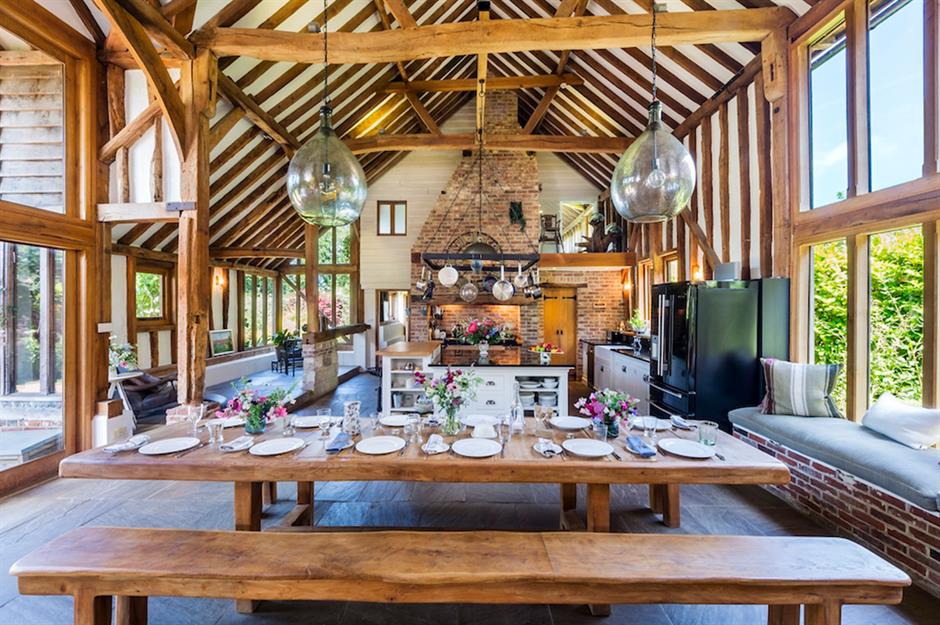
If your open-plan space has characterful features like exposed beams or support columns, don't try to disguise them. Instead, let these architectural quirks enhance your scheme for a completely unique interior. In this beautiful barn conversion, characterful woodwork and an original brick hearth frame a charming country-style living space.
Conceal your kitchen
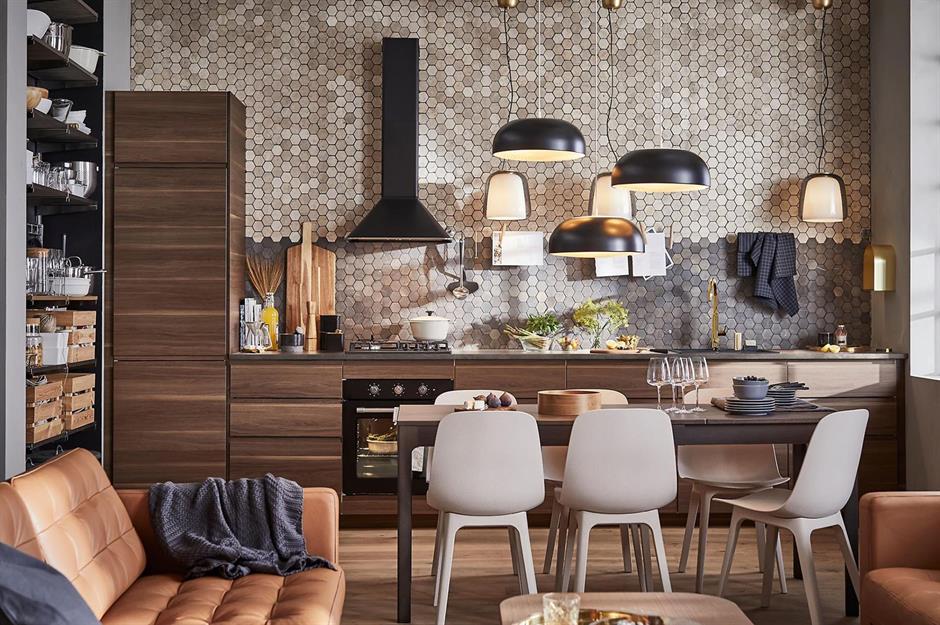
For a cohesive open-plan space, make the kitchen area as unobtrusive as possible with clever design and sleek finishes. Here, the kitchen units run along the back wall and are raised off the floor. The unit fronts are simple, contemporary and handleless, plus they fit in with the scheme's chocolate brown tonal palette. When not in use, this kitchen has the air of a smart sideboard at the edge of the dining space. This would look equally as good in a classic white or sleek black scheme.
Slot in a desk
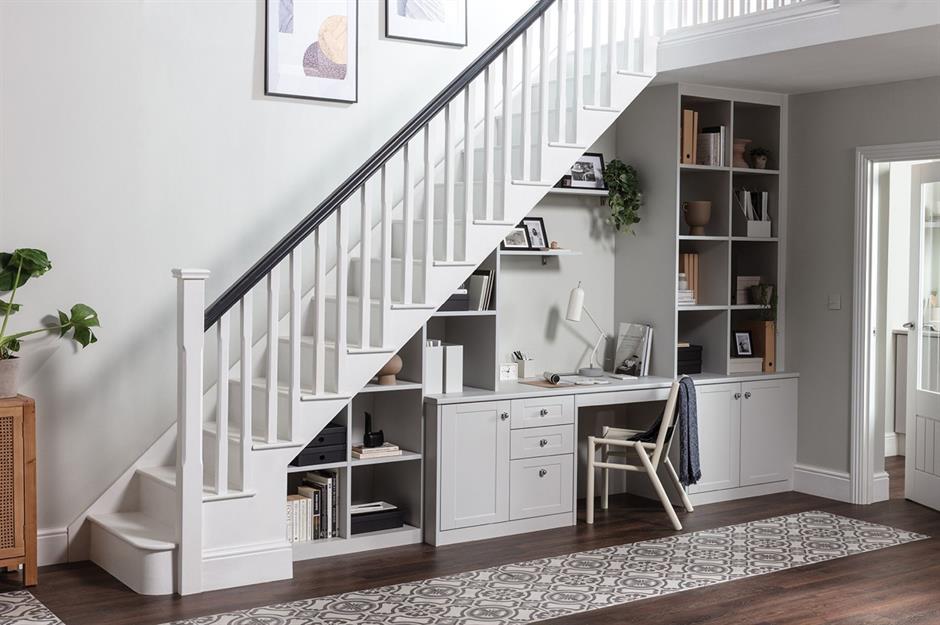
A home without walls means you may have to factor in multipurpose spaces. Create a hardworking home office that's still part of the wider scheme with a desk that's in keeping with your décor. Don't neglect smart storage either, as it'll be on display all the time. If privacy is an issue, you could close off the area with a curtain or freestanding screen.
Pick flooring for all zones
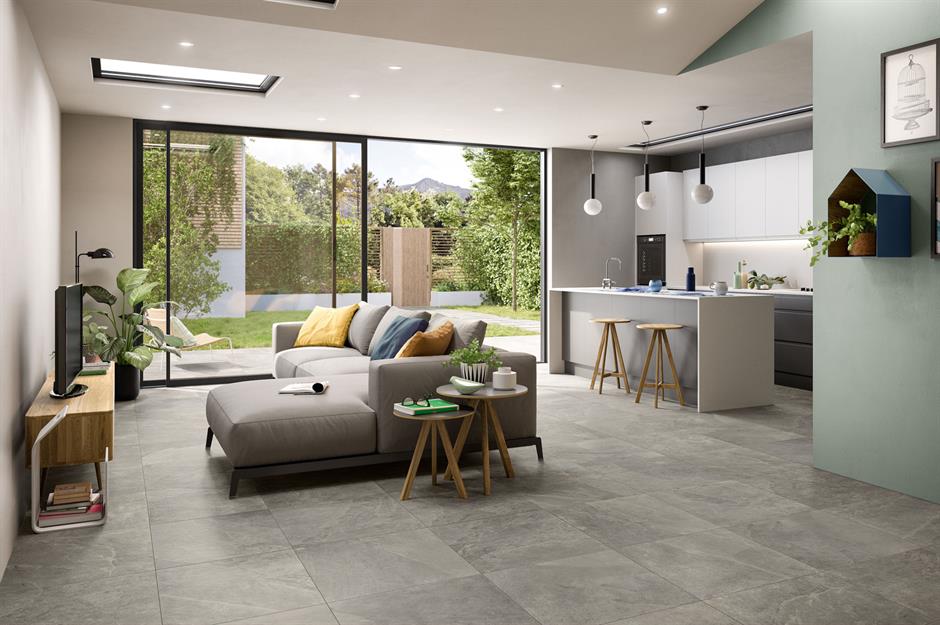
Using the same flooring throughout your open-plan living room will maximise the sense of space. Choose a coherent material that is slip-resistant and will withstand spillages in the kitchen, yet look timeless and soothing in the living area.
Divide with shelving
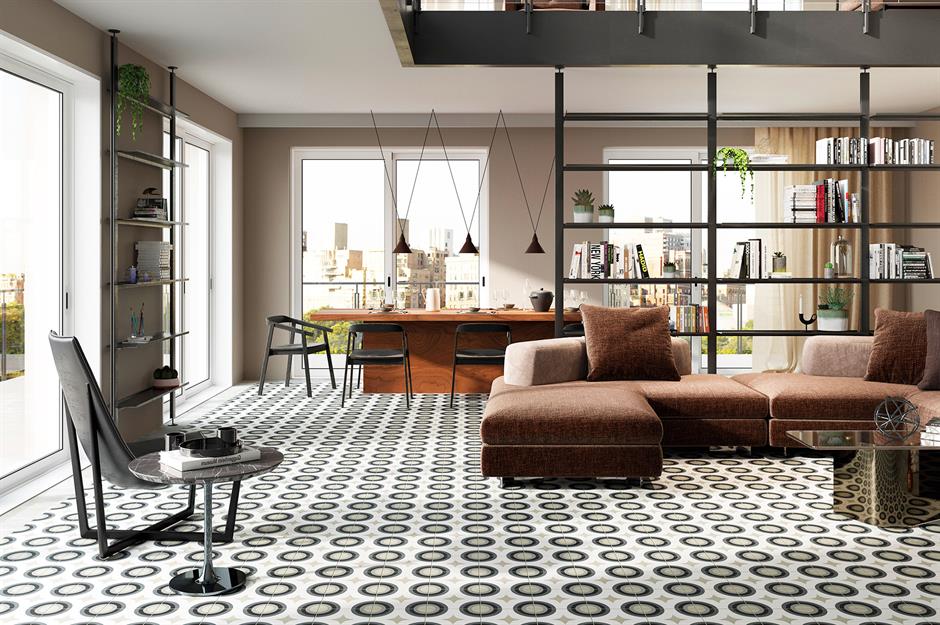
To give a large room instant shape and structure, use freestanding furniture to differentiate the various areas. A simple shelving unit placed between the lounge and dining space is an easy way to zone a large multiuse space, plus it'll give you practical extra storage.
Make it work for everyone
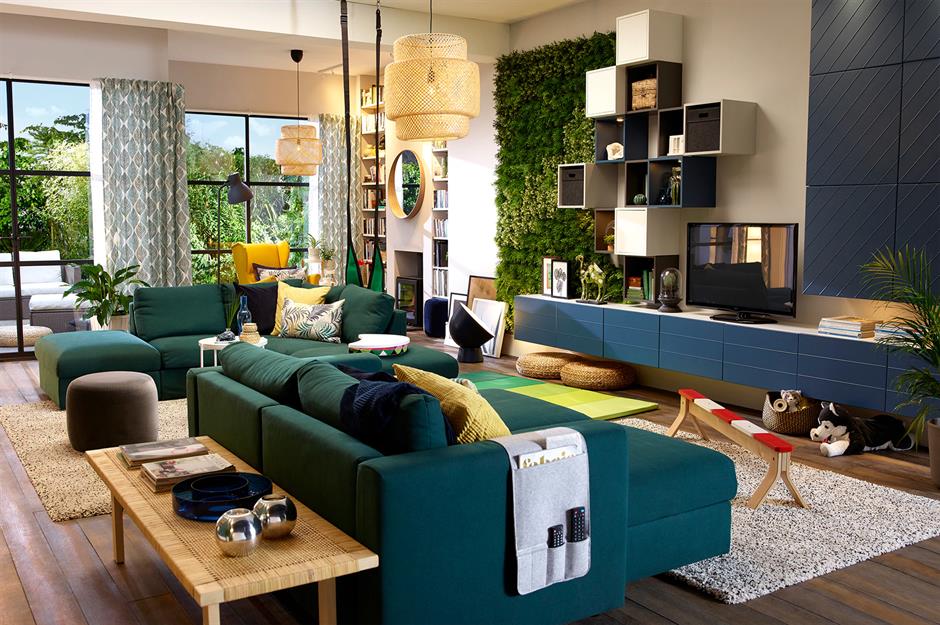
Streamline appliances
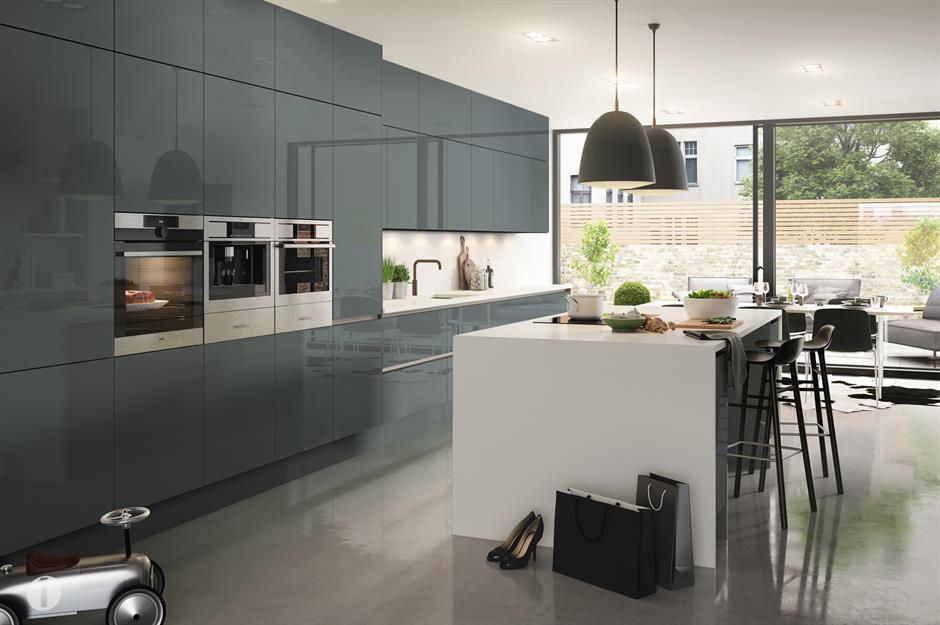
Duplicate furniture
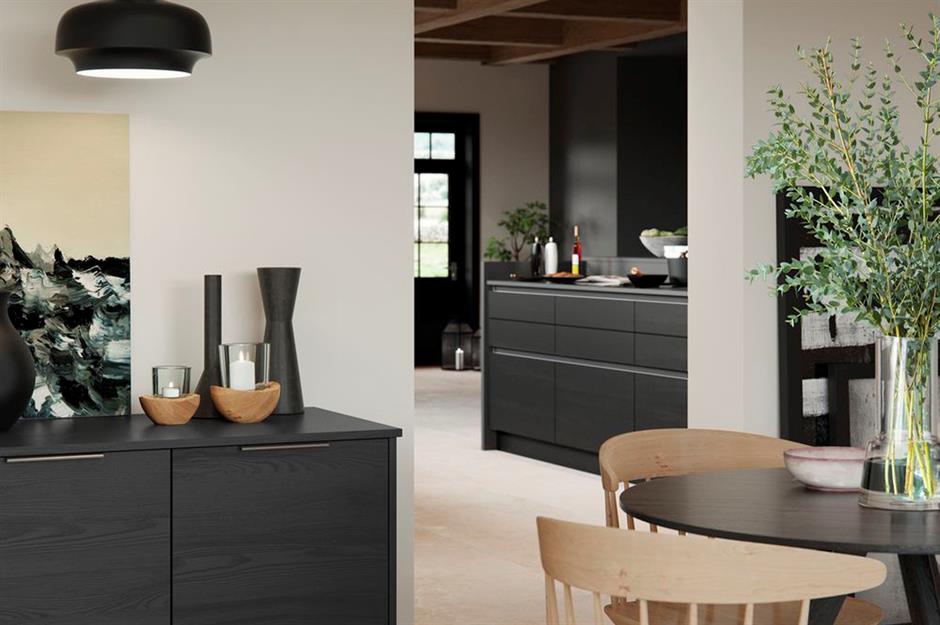
Consistency is key and will make your open-plan home look streamlined and elegant. Create a visual link between spaces by choosing matching furniture. Here, pale neutral walls allow black fixtures and accessories to become the main feature, seamlessly blending one zone into another.
Put a peninsula to work
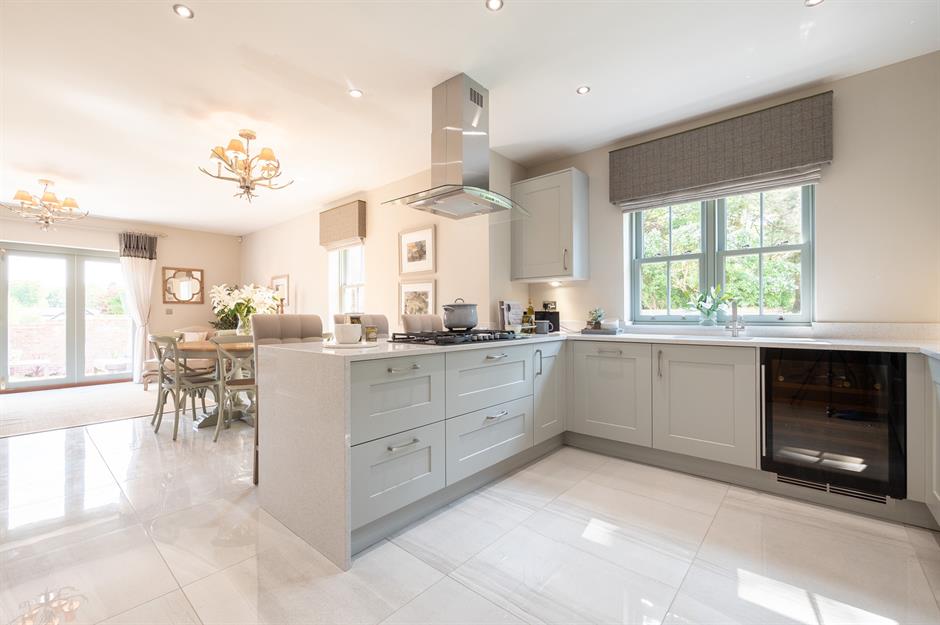
A peninsular unit that juts out at a right angle from a wall of units can help you to create a natural barrier between your kitchen and the rest of the space. It can also provide useful additional countertop and storage space for the kitchen while doubling up as a breakfast bar too.
Add a skylight

In large open spaces with windows limited to one aspect, the area in the middle can often be starved of light. Installing a skylight or a glass lantern can make the world of difference, bathing the heart of the room in natural light. Install electric blinds on those lightwells too, so when you do want a cosy feel at night it's easy to shut out the outside world.
Wheel in furniture
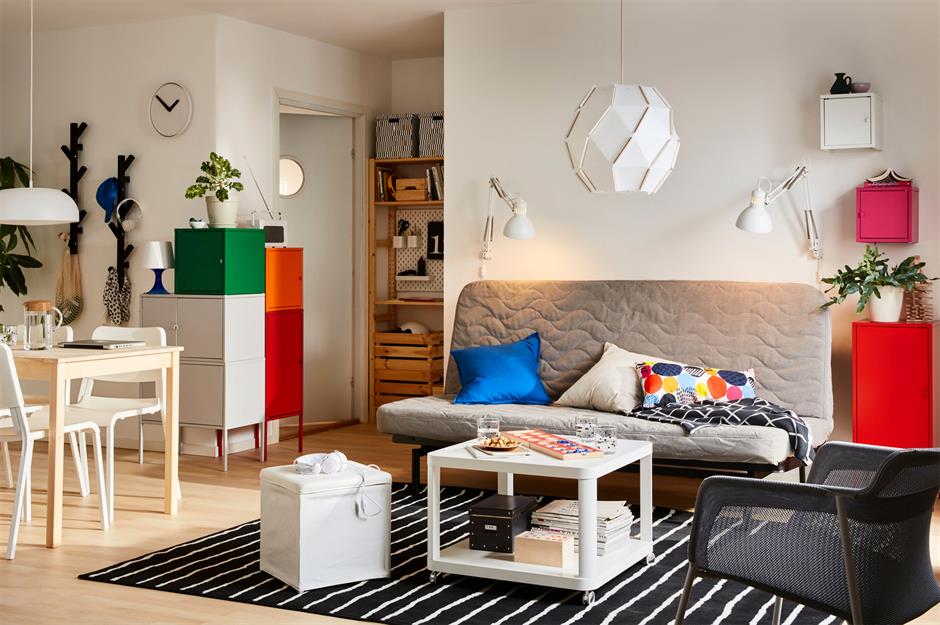
Step it up
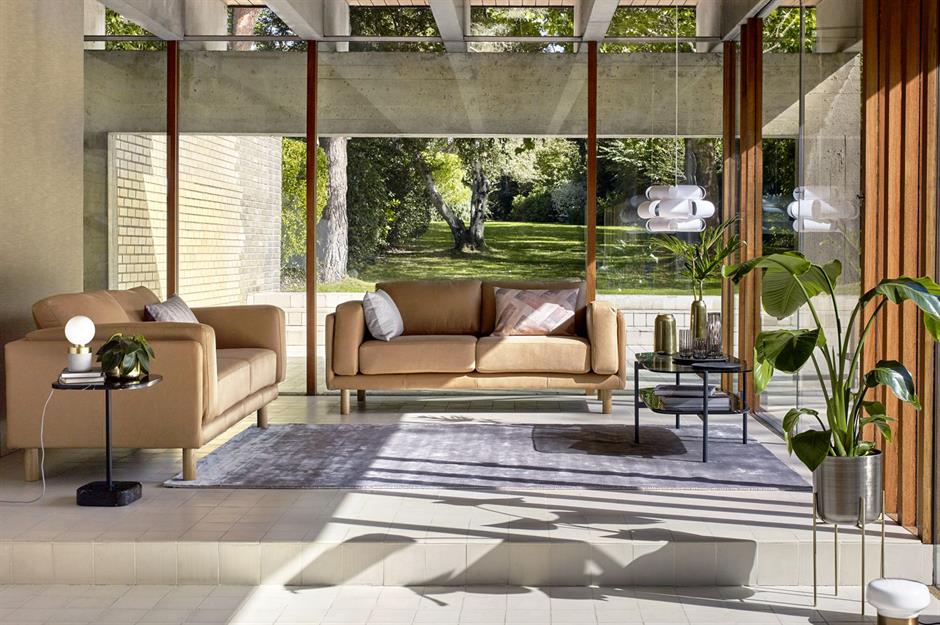
Consider your interior floor plan. Creating a split-level floor in your open-plan space will help to discreetly zone off different areas. Here, a small step takes you up to the light-filled living area. Meanwhile, a step down could be used as a transition into a cosy snug or a more formal dining space.
Make room for play
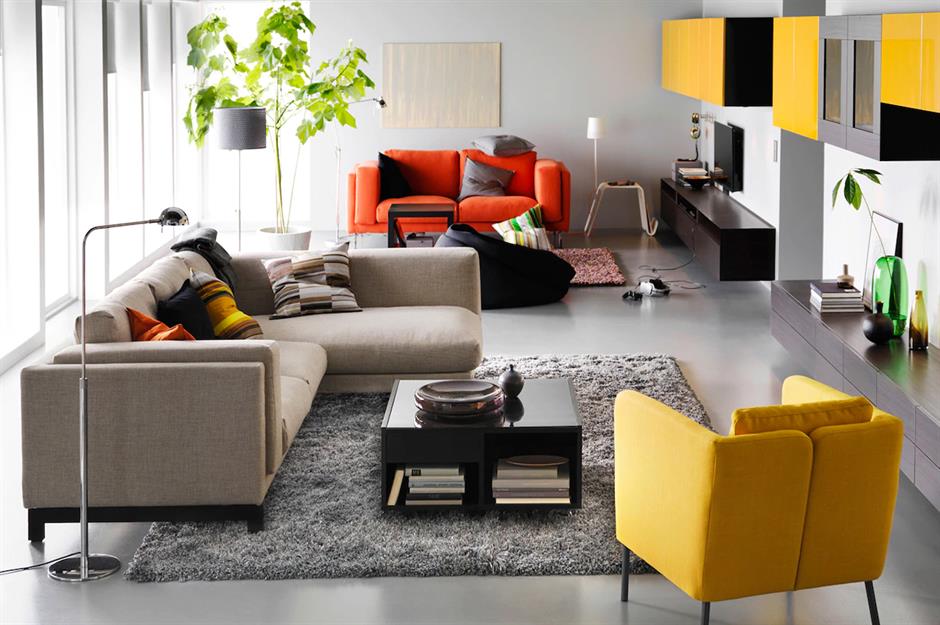
The beauty of an open-plan living area is that it allows you to watch over young children playing and older kids doing homework, while you kick back and relax or get on with other tasks. Consider including a playmat, study desk or even a games zone in your layout. To avoid the space being completely taken over by toys and tech, invest in boxes or baskets that can be tucked away out of sight.
Plump for a partition
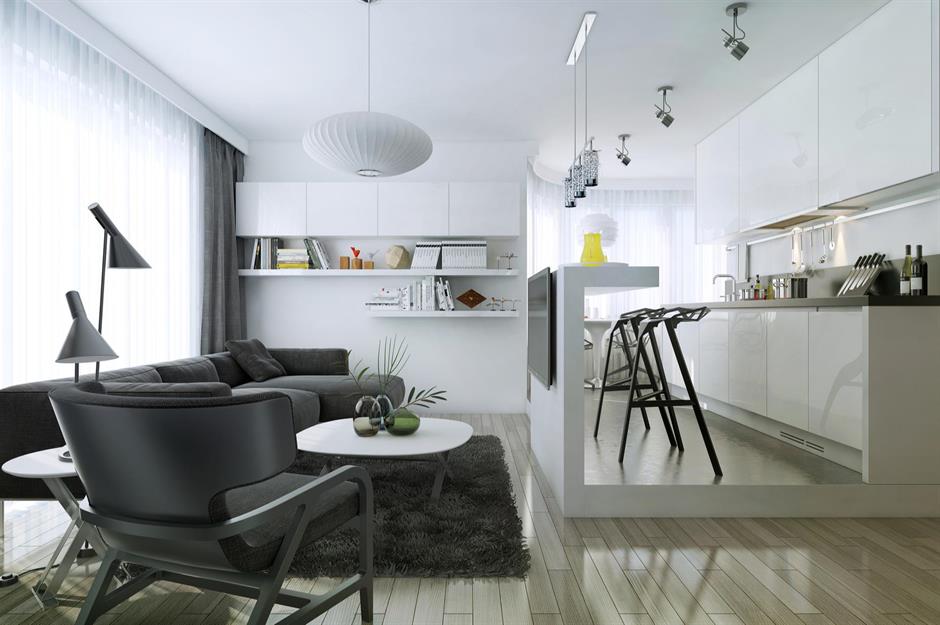
In an open-plan studio flat or small space, a half-wall can work well to screen off the kitchen from the rest of the room without blocking out any light. A neat little breakfast bar has been created on one side of this wall, while the other side supports the TV, which faces out into a cosy living area.
Maximise extraction
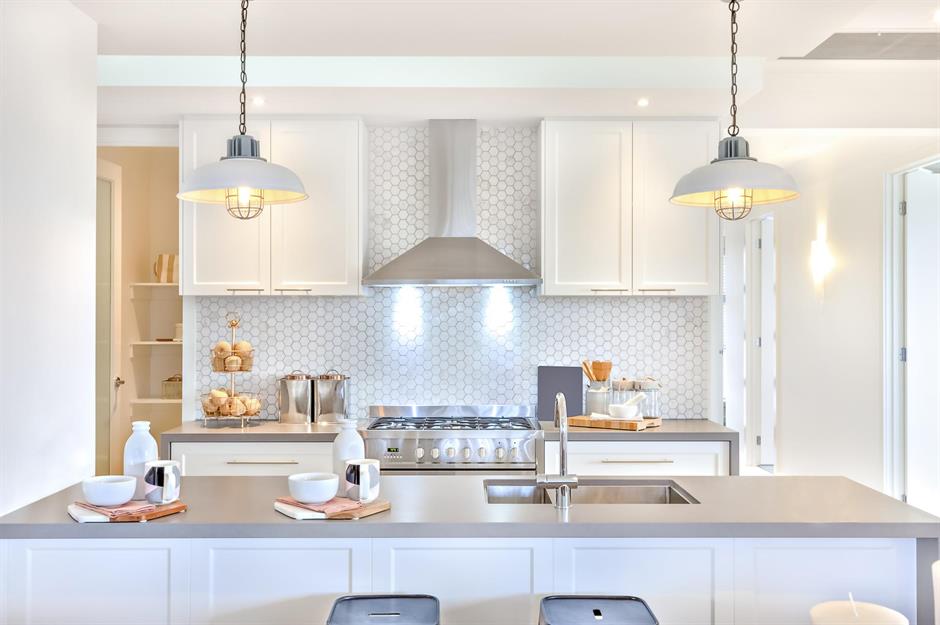
Don't skimp on storage
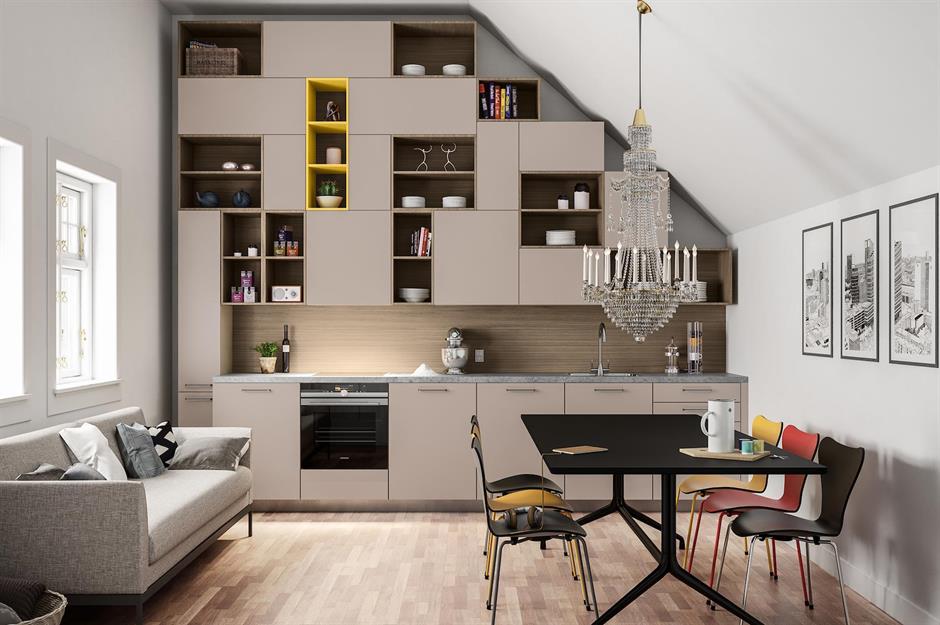
Keeping an open-plan space tidy can be a challenge – especially if you have a family. The easiest way to stay organised is to have a place for everything. This means investing in a mix of hidden storage and display areas for those more attractive items. Here, the kitchen units, broken up by open shelving, have been taken right up to the ceiling so there's no redundant space.
Colour-code zones
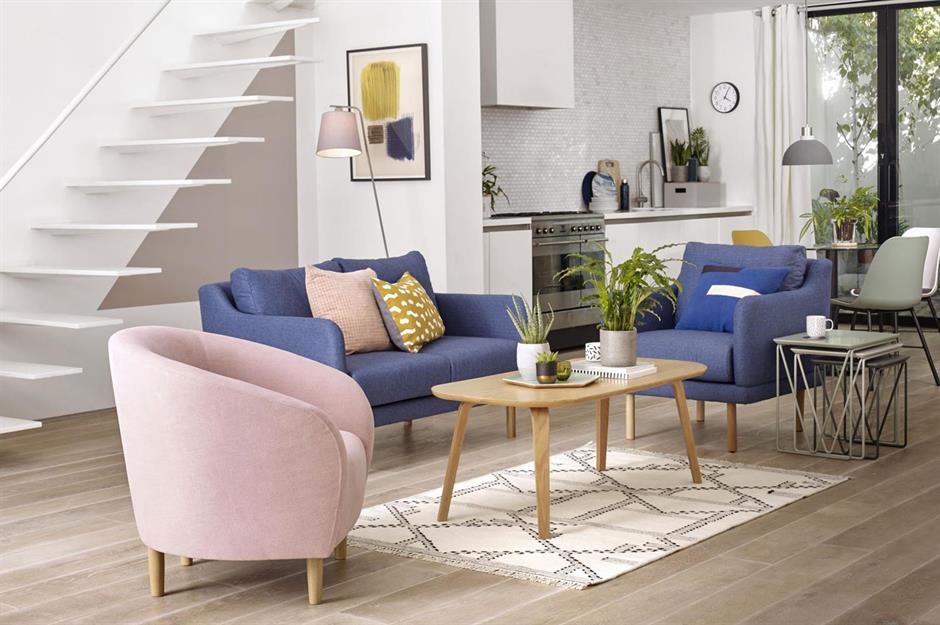
If you want to create a distinction between your living zones without ending up with a jarring, disconnected scheme, decorate each individual area with different hues. Here, deep blue and powder pink armchairs define this sitting area, while pale sage accents dominate the kitchen. Pops of yellow create a cohesive link between the two spaces.
Choose space-savvy furniture
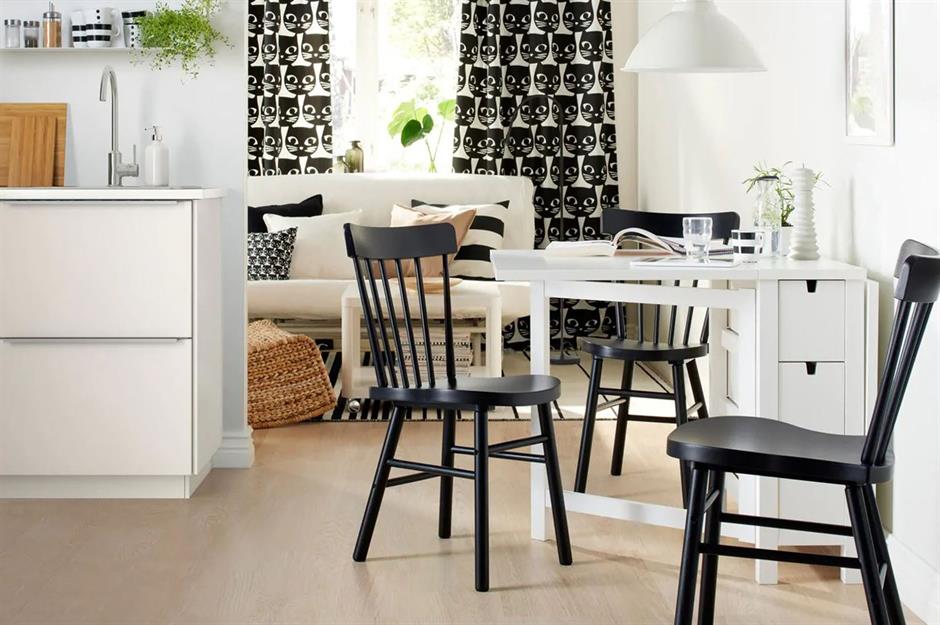
For open-plan rooms where space is at a premium, consider investing in clever furnishings that have been specially made for snug schemes. This angular IKEA table frees up the thoroughfare with its unique triangular design, which can also extend to double the length to accommodate guests when needed.
Choose the right furniture
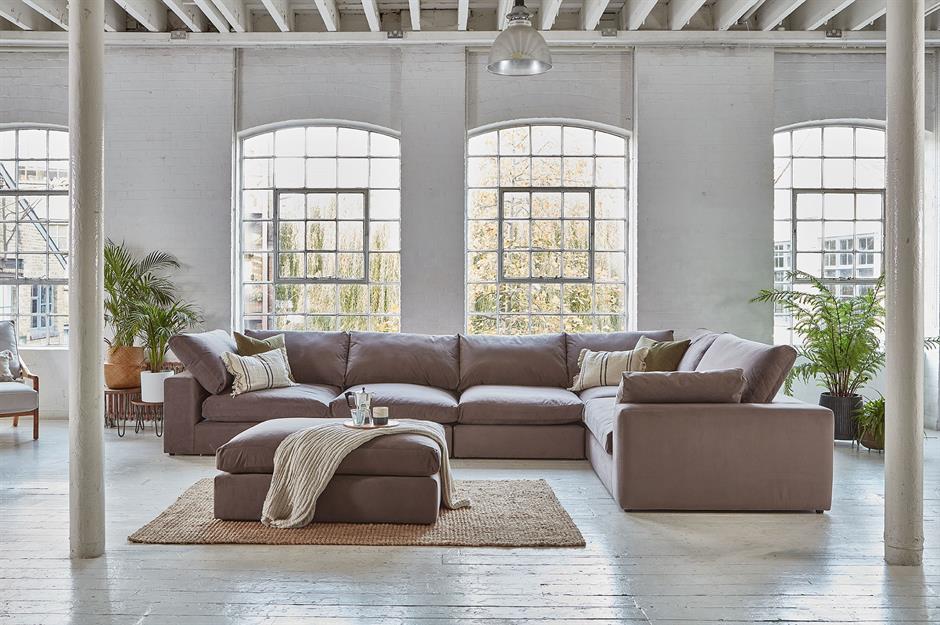
When working with an open floorplan, it's essential that you keep your furnishings in proportion to the space you're working with. Large spaces will require more furniture to add warmth and a sense of homeliness, while smaller spaces shouldn’t be overwhelmed with too many items. You don’t have to choose over-sized furnishings, but consider how each piece will fill the space to avoid empty expanses with no clear purpose.
Loved this? Find more DIY and decorating ideas here
Comments
Be the first to comment
Do you want to comment on this article? You need to be signed in for this feature